1. Introduction
The Sentencing Council for England and Wales was set up in 2010 and produces guidelines for use by all members of the judiciary when sentencing after conviction in criminal cases. The Council promotes a clear, fair, and consistent approach to sentencing by issuing sentencing guidelines and explanatory materials. It has a statutory duty to monitor these sentencing guidelines and to draw conclusions from the information obtained (s129 Coroners and Justice Act 2009).
On 1 October 2018, the Council published the intimidatory offences guidelines, which are a package of five guidelines covering 11 offences, including harassment and stalking offences. The five guidelines are for use in all courts and apply to all adult offenders (those aged 18 or over at the time of sentence). The guidelines came into force on 1 October 2018 and cover:
- a combined guideline covering the offences of harassment, stalking and racially or religiously aggravated harassment/stalking
- a combined guideline covering the offences of harassment (putting people in fear of violence), stalking (involving fear of violence or serious alarm or distress), and racially or religiously aggravated harassment (putting people in fear of violence)/stalking (involving fear of violence or serious alarm or distress)
- threats to kill
- disclosing private sexual images
- controlling or coercive behaviour in an intimate or family relationship
The Council developed guidelines to replace the Magistrates’ Court Sentencing Guidelines (MCSG) for harassment, harassment (putting people in fear of violence), racially or religiously aggravated harassment, racially or religiously aggravated harassment (putting people in fear of violence) and threats to kill, to provide more detailed guidance as these guidelines were only applicable to the magistrates’ courts.
Additionally, the package introduced new guidelines for stalking, stalking (involving fear of violence or serious alarm or distress), racially or religiously aggravated stalking, and racially or religiously aggravated stalking (involving fear of violence or serious alarm or distress), as there were no guidelines previously covering these offences. The guidelines also covered the newer offences of disclosing private sexual images and controlling or coercive behaviour in an intimate or family relationship which were introduced in 2015.
The aims of the guidelines are to ensure that all sentences are proportionate to the offence committed and in relation to other offences.
1.1 Terminology
On 1 August 2023, the Disclosing private sexual images guideline was renamed to the Disclosing or threatening to disclose private sexual images guideline. This is because of an amendment to the Domestic Abuse Act 2021, which meant threats to disclose private sexual photographs and films became an offence in addition to the existing offence of disclosing private sexual images. The only change made to this guideline was to the title. For consistency with the offence covered at the time of publication, and for which any analysis has been conducted for this report, it will be referred to as the Disclosing private sexual images guideline hereafter.
There are two combined guidelines covering multiple harassment and stalking offences. For simplicity, the relevant stated guideline will be referred to by a shortened name, instead of the full list of offences covered by the guideline. The guideline covering harassment, stalking, and racially or religiously aggravated harassment/stalking will be referred to as the Harassment and stalking guideline. The guideline covering harassment (putting people in fear of violence), stalking (involving fear of violence or serious alarm or distress), racially or religiously aggravated harassment (putting people in fear of violence)/stalking (involving fear of violence or serious alarm or distress) will be referred to as the Harassment and stalking (fear of violence) guideline.
The data sources in this report use different terminology for sentence outcomes. Community orders (COs) are recorded in the Ministry of Justice’s Court Proceedings Database (CPD) as community sentences. Suspended sentence orders (SSOs) are referred to as suspended sentences. For the sake of consistency, we will only refer to community orders (COs) and suspended sentence orders (SSOs) in this report as this more closely aligns with the terminology used in Sentencing Council guidelines.
Additionally, the term ‘custodial sentences’ refers to both SSOs and immediate custodial sentences.
2. Approach
2.1 Aims
One of the Sentencing Council’s statutory duties under the Coroners and Justice Act 2009 section 128 is to monitor the operation and effect of its sentencing guidelines and to draw conclusions from this information. To evaluate the operation and effect of the intimidatory offences guidelines, this report will review whether the guidelines may have had any impact on sentencing outcomes and explore whether there were any issues with implementation. Furthermore, it will review whether any changes which have taken place were in line with those outlined in the Sentencing Council’s resource assessment of the intimidatory offences guidelines. These are summarised in Table 1 below.
Table 1: Estimated changes to sentence outcomes as a result of the intimidatory offences guidelines
| Offence(s) | Estimated changes to sentence outcomes |
| Harassment and stalking | No changes to sentence outcomes. |
| Harassment (putting people in fear of violence) and stalking (involving fear of violence or serious alarm) | No changes as a result of the guideline but a small increase in offenders falling into the highest category of seriousness is anticipated following a statutory maximum sentence increase from 5 to 10 years’ custody. |
| Racially or religiously aggravated harassment/ stalking | A potential increase in sentences for these offences and an increase in sentence lengths for those sentenced to immediate custody, although this was only expected to lead to a small impact as the offences are low volume. |
| Racially or religiously aggravated harassment (putting people in fear of violence) and stalking (involving fear of violence or serious alarm or distress) | A potential increase in sentences for these offences and an increase in sentence lengths for those sentenced to immediate custody, although this was only expected to lead to a small impact as the offences are low volume.
Any increase as a result of the statutory maximum sentence increase (from 7 to 14 years’ custody) for racially or religiously aggravated harassment (putting people in fear of violence) and stalking (involving fear of violence or serious alarm or distress) would not be attributable to the guideline. |
| Threats to kill | No changes to sentence outcomes. |
| Disclosing private sexual photographs and films with intent to cause distress | No changes to sentence outcomes. |
| Controlling or coercive behaviour in an intimate or family relationship | No changes to sentence outcomes. |
Source: Sentencing Council’s resource assessment of the intimidatory offences guidelines
Given the data available, this is a descriptive evaluation and it has not been possible to account for the impact of additional factors on sentence outcomes (for example, changes in charging decisions for offences, or other guidelines). It is also not possible to conclude definitively whether the introduction of the intimidatory offences guidelines caused the changes seen in sentence, either in terms of changes to severity of sentencing or consistency in outcomes.
However, by comparing the observed changes in sentencing data and analysing available qualitative sources, the Council can consider whether the guidelines are working as anticipated and decide whether any further work on the intimidatory offences guidelines needs to be conducted. The Council is also continuing to explore options for measuring consistency as part of its wider work (see Annex A for more information).
2.2 Methodology
The Council has taken a mixed methods approach to the evaluation, including quantitative analysis of sentencing data from the Ministry of Justice’s Court Proceedings Database (CPD) and from the Council’s own magistrates’ court data collection, and qualitative analysis of transcripts of Crown Court sentencing remarks and a review of Court of Appeal transcripts.
2.2.1 Ministry of Justice (MoJ) Court Proceedings Database (CPD)
The MoJ’s CPD was used to produce statistics on volumes, outcomes and sentence lengths for all of the intimidatory offences, for the 12 month period before the intimidatory offences guidelines came into effect (July 2017 to June 2018) and the 12 month period afterwards (October 2018 to September 2019). This period excludes the time when the guidelines had been published but were not yet in force. The data was used to observe the changes in the type of principal disposals being imposed and the average custodial sentence length (ACSL) for each of the offences (see Annex A for further information).
For each of the offences, type of disposals imposed and ACSLs were also examined between 2012 and 2022 to review whether any changes were part of a longer term trend. This report includes data up until 2022, as this was the last period of data available at the time of analysis.
For more information on this data source, including limitations, please see Annex A at the end of the report.
2.2.2 Magistrates’ court data collection
A data collection exercise covering the pre guideline and post guideline periods was conducted to further aid our understanding of how these cases are sentenced in courts, and to explore any changes in sentencing practice following the introduction of the intimidatory offences guidelines.
The data collection was undertaken in magistrates’ courts to collect more detailed information on sentencing, for example, on culpability, harm, aggravating and mitigating factors, in addition to sentence starting points and final sentence outcomes. The data collection gathered data on the offences of harassment and stalking, which are summary only offences, typically sentenced in the magistrates’ courts.
The first phase of the data collection ran from 1 November 2017 to 30 March 2018 prior to the implementation of the guideline: referred to as the ‘pre guideline’ period. It was predominantly conducted using online forms, although a small volume of data were collected with paper forms. The second phase of the collection ran from 23 April 2019 to 30 September 2019, after the guideline was in force. This is referred to as the ‘post guideline’ period, and data were collected using online forms only. All sentencers were requested to fill in a form for each harassment and stalking case sentenced in the magistrates’ courts, where the offender was an adult.
It is worth noting that the pre and post guideline periods for the magistrates’ court data collection differ from the pre and post guideline periods used for analysis of the CPD. The magistrates’ court data collections cover a shorter window (approximately 5 months pre guideline and 5 months post guideline) within the CPD pre and post guideline time periods (which each cover a 12 month window).
The figures in Table 2 reflect the number of responses to in the magistrates’ court data collection after data cleaning, where some records were excluded due to not meeting the data collection criteria or due to poor quality (missing or contradictory information within a record). More information on the data cleaning exercise and exclusions has been published alongside this evaluation: Harassment and stalking data collection.
Table 2: Number of responses from the magistrates’ court data collection
| Offence | Pre guideline | Post guideline |
| Harassment | 225 | 271 |
| Stalking | 27 | 61 |
| Total | 252 | 332 |
Source: Magistrates’ court data collection from the Sentencing Council
The data collection for harassment returned a 13 per cent response rate for the pre guideline period. Post guideline, there was a response rate of 21 per cent.
The data collection for stalking returned a pre guideline response rate of 14 per cent and a post guideline response rate of 27 per cent. Stalking is a much lower volume offence than harassment which means that, although the response rates are similar, the actual number of responses collected for stalking was much lower and caution will therefore need to be taken when interpreting the data. For more information on the limitations of this data source please see Annex A.
Analysis of the data included comparing differences pre and post the guidelines’ introduction for:
- sentence outcomes, including detailed analysis of sentence starting points and final sentence outcomes
- types of factors considered in sentencing the offender (culpability, harm, aggravating factors, mitigating factors)
- the distribution of offending in terms of seriousness, culpability, and harm
2.2.3 Crown Court sentencing transcripts
Sentencing remarks are given by the judge at the final stage of the sentencing process and provide an explanation of the reasons behind a sentence that has been imposed. These can therefore provide more insight as to both how and why a particular sentence outcome was arrived at, and how the guideline has been used in practice.
A content analysis was conducted on a small sample of transcripts of judge’s sentencing remarks for the either-way intimidatory offences:
- Harassment (putting people in fear of violence)
- Stalking (involving fear of violence or serious alarm or distress)
- Racially or religiously aggravated harassment/stalking
- Racially or religiously aggravated harassment (putting people in fear of violence)/stalking (involving fear of violence or serious alarm or distress)
- Threats to kill
- Disclosing private sexual photographs and films with intent to cause distress
- Controlling or coercive behaviour in an intimate or family relationship
These offences can be heard in the magistrates’ courts or the Crown Court, but sentencing remarks are only available at the Crown Court. This means any sample of transcripts for these offences would not reflect all offending and instead would likely reflect the more severe end of sentencing. No transcripts for harassment or stalking were analysed, as these are summary only offences and transcripts are not available in magistrates’ courts.
Analysis of these transcripts differed between offences depending on the volume of transcripts, with sample sizes ranging from 13 to 34.
For most offences a random stratified sampling method was used to select a sample that represented the range of sentence outcomes and custodial sentence lengths received. However, for some offences, the sample was selected to include particular types of cases; for example, for offences where the statutory maximum sentence changed, cases receiving the longest custodial sentences were oversampled. This was to ensure that cases of specific interest were sampled in high enough volumes to be able to explore any potential issues. The specific approach to the transcript sampling has been included within the discussion of offence specific findings.
Transcripts were ordered from 2019 and 2020 to examine any issues with the introduction of the intimidatory offences guidelines. Analysis included:
- reviewing the frequency of factors (for example, culpability, harm, mitigating and aggravating) post guideline, to help understand what types of cases fell into the different culpability and harm categories, and
- reviewing potential implementation issues with the guidelines, for example, whether the additional steps required for the racially or religiously aggravated offences were followed as stated by the guidelines
2.2.4 Court of Appeal transcripts
Content analysis of Court of Appeal judgments was also conducted to investigate whether the reasons put forward for any appeals against sentences related to the implementation of the guideline. A small sample of ten successful appeals from 2022 were reviewed for the available offences: harassment (putting people in fear of violence), stalking (involving fear of violence or serious alarm or distress), racially or religiously aggravated harassment, threats to kill and controlling or coercive behaviour in an intimate or family relationship.
Analysis involved reviewing whether the reason for the appeal and the explanation for the successful appeal included references to specific features of the sentencing guideline. For example, reviewing whether there were difficulties in interpreting particular factors in the guideline.
2.3 General conventions
2.3.1 Rounding
For figures reported from the CPD, actual numbers of sentences have been rounded to the nearest 100 when more than 1,000 offenders were sentenced, and to the nearest 10 when fewer than 1,000 offenders were sentenced. An exception is when reporting on the sample or population totals underneath graphs and figures, where the actual total has been stated. Proportions of sentencing outcomes have been rounded to the nearest integer.
Percentages in this report may not appear to sum to 100 per cent, due to rounding. Percentages have been rounded to the nearest integer. Percentage point differences may not sum to zero as they have been calculated using unrounded percentages.
2.3.2 Interpretation of the tables and graphs
For each table and graph, the data source (CPD, magistrates’ court data collection etc) will be indicated underneath.
Throughout the report, different time periods are presented, for example, monthly, quarterly or yearly, and these are stated in the table or graph title. If a specific time period e.g. ‘pre guideline’ or ‘post guideline’ has been used, the time period and base sizes will be stated underneath the table or graphic e.g. ‘Pre guideline period covers 1 July 2017 to 30 June 2018 (N=487), post guideline period covers 1 October 2018 to 30 September 2019 (N=595)’.
If a time period in a table crosses more than one year (e.g. 1 October 2018 to 30 September 2019) then figures relating to this time period will not be directly comparable to a graph where data is based on a total monthly, quarterly or yearly volume or proportion.
In graphs which are representing a monthly, quarterly or yearly time period, each data point (a dot on the graph) represents the total number or proportion for the month, quarter or year. This means when interpreting changes in the graph, if a proportion is e.g. 50 per cent in September, and 60 per cent in October and there is a line joining the two data points, this should be interpreted as there being a higher proportion in October, not that there was a steady increase across or between September and October.
3. Offence specific findings
The offences of harassment, stalking and racially and religiously aggravated forms of these offences are all covered under one guideline, and the equivalent offences of harassment (putting people in fear of violence) and stalking (involving fear of violence or serious alarm or distress) and the racially and religiously aggravated forms are all covered under another singular guideline. However, as the impact of these guidelines on sentencing practice for each offence may differ, each offence has been examined separately.
In this section, findings for harassment and then stalking are first discussed, followed by harassment (putting people in fear of violence) and stalking (involving fear of violence or serious alarm or distress). Following these sections, there are two sections covering the racially and religiously aggravated forms of the aforementioned offences. The racially and religiously aggravated forms of harassment and stalking were considered together, as they were not split by harassment and stalking in the data in the Court Proceedings Database (CPD). Following these sections, the offences of threats to kill, disclosing private sexual photographs and films with intent to cause distress are discussed, as well as controlling or coercive behaviour in an intimate or family relationship.
Some of the data presented in this report covers the period from March 2020 in which restrictions were in place on the criminal justice system due to the coronavirus (COVID-19) pandemic (see Annex A for further details). For relevant offences, where the data indicates sentencing may have been impacted by COVID-19 and where these changes may affect the interpretation of the impact of the guidelines, the impact of COVID-19 has been discussed.
Many of the offences covered by the intimidatory offences guidelines are often conducted in a domestic context. The Domestic Abuse Overarching Principles guideline (Domestic abuse guideline hereafter) came into force in May 2018, six months before the intimidatory offences guidelines, and it is possible that this guideline may have had an impact on the sentencing of some of these offences, as courts reflected the domestic abuse context that may have been present within some of the offending. Please see the Research review of the Overarching principles: domestic abuse guideline for more information on the impact of this guideline.
Additionally, this report discusses the potential impacts of the Imposition of community and custodial orders guideline that came into force on 1 February 2017 (the Imposition guideline hereafter).
Given the timing of the in force date for the Imposition guideline, it is possible that any impacts of that guideline may overlap with those associated with the intimidatory offences guidelines. Further discussion of any potential overlap between the two guidelines will be covered in relevant offence specific sections. This will not cover any small changes to the intimidatory offences guidelines that have been introduced since October 2018, and which are not expected to have had a substantial impact on sentencing outcomes.
3.1 Harassment
3.1.1 Summary of findings
- For the offence of harassment there was an increase in community orders (COs) as a sentence outcome, and a corresponding decrease in suspended sentence orders (SSOs) and fines after the Harassment and stalking guideline came into force, despite no intention for the guideline to change sentencing practice.
- Some modest changes in sentencing outcomes emerged following the publication of a letter in April 2018 reminding sentencers about the principles of the Imposition guideline. Following the introduction of the Harassment and stalking guideline a further increase was seen in the proportion of COs, and a decrease in SSOs.
- No substantial or sustained changes to the mean average custodial sentence length (ACSL) were seen post guideline for harassment, suggesting the guideline did not have an impact on the length of custodial sentences issued.
3.1.2 Background
The offence of harassment (Protection from Harassment Act 1997, s.2) is a summary only offence, with a statutory maximum sentence of 6 months’ custody. Prior to the Harassment and stalking guideline coming into force on 1 October 2018, there was a Magistrates’ Court Sentencing Guideline (MCSG) for harassment, which had been in force from 4 August 2008.
The Sentencing Council’s resource assessment of the intimidatory offences guidelines stated the aim of the guideline was to improve consistency of sentencing and to maintain current sentencing practice for harassment. There was no intention to change the use of disposal types, and the sentencing ranges in the Harassment and stalking guideline were set with current sentencing practice for harassment in mind. Furthermore, consultation stage research suggested sentencing levels for harassment were similar under the MCSG for harassment and the new Harassment and stalking guideline. Overall, the resource assessment anticipated there would be no impact on prison and probation resources as a result of the introduction of the Harassment and stalking guideline for harassment.
3.1.3 Trend analysis
Sentence volumes
Harassment is the highest volume offence covered by the intimidatory offences guidelines. The number of offenders sentenced for this offence has been steadily declining since 2015 when volumes peaked at 5,400 (Figure 1) and were already in decline when the guideline came into force in October 2018. The majority of offenders are sentenced at magistrates’ courts as harassment is a summary only offence.
Figure 1: Number of adult offenders sentenced for harassment, by court type, 2012 to 2022
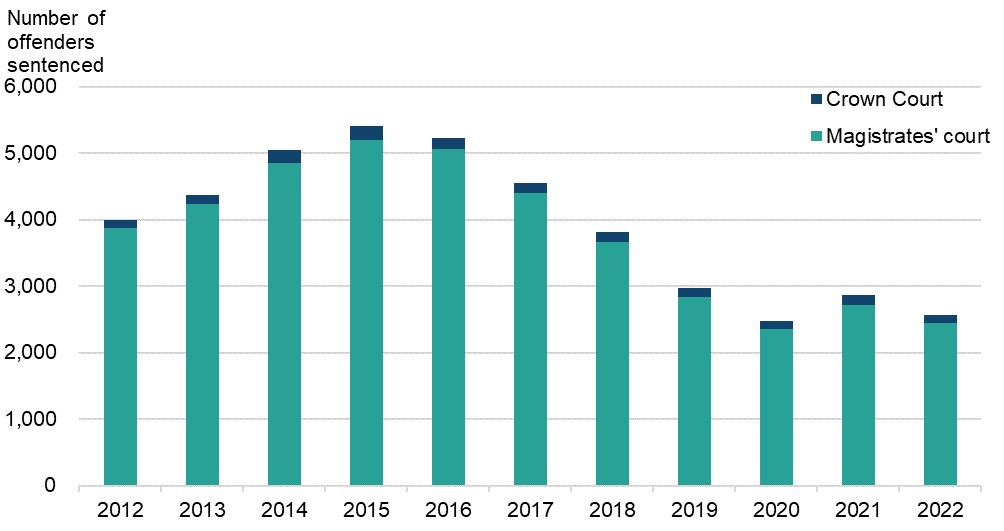
Source: Court Proceedings Database from the Ministry of Justice
Sentence outcomes
Analysis using the Court Proceedings Database (CPD) was conducted to compare sentence outcomes in the pre guideline period (1 July 2017 to 30 June 2018) with those in the post guideline period (1 October 2018 to 30 September 2019). The figures in Table 3 indicate the Harassment and stalking guideline may have contributed to some changes in sentencing practice contrary to the expectations outlined in the intimidatory resource assessment.
Table 3: Proportion of adult offenders sentenced for harassment, by sentence outcome, pre and post guideline
Some shorthand may be used in this table: z = not applicable, k2 = less than 0.5 percentage point difference.
| Sentence outcome | Pre guideline | Post guideline | Percentage point (ppt) difference |
| Absolute or conditional discharge | 10% | 11% | 2 ppts |
| Fine | 20% | 16% | -4 ppts |
| Community order | 43% | 52% | 9 ppts |
| Suspended sentence order | 15% | 9% | -7 ppts |
| Immediate custody | 11% | 10% | -1 ppt |
| Other/unknown | 1% | 1% | [k2] |
| Total | 100% | 100% | [z] |
Source: Court Proceedings Database from the Ministry of Justice
Pre guideline period covers 1 July 2017 to 30 June 2018 (N=4,332), post guideline period covers 1 October 2018 to 30 September 2019 (N=3,153). Percentage totals and percentage point differences may not appear to sum correctly due to rounding.
In the year following the guideline coming into force there was a 9 percentage point increase in community orders (COs). There was also a decrease in suspended sentence orders (SSOs) (7 percentage points) and fines (4 percentage points) for those sentenced for harassment, as compared with the pre guideline period.
The changes in the proportion of sentence outcomes seen in the post guideline period persist beyond the immediate year following the introduction of the Harassment and stalking guideline (see Figure 2). In 2022, the proportion of COs issued remained at approximately 50 per cent, similar to the proportion of COs issued in the post guideline period of 52 per cent. The proportion of SSOs, which decreased in the post guideline period to 9 per cent, increased again slightly in 2020 but remained at around 11 per cent in 2022, a lower proportion compared with the pre guideline period (15 per cent).
Figure 2: Proportion of adult offenders sentenced for harassment, by sentence outcome, by year, 2012 to 2022

Source: Court Proceedings Database from the Ministry of Justice
Given the unanticipated changes seen in sentence outcomes, another factor was considered which may have contributed over this time period to this pattern in sentencing: the Imposition guideline. The Imposition guideline originally came into force on 1 February 2017. It was developed in part to ensure sentencers were not using SSOs as a more severe form of a CO, where the custody threshold had not been crossed. As stated in the Imposition guideline resource assessment the introduction of the Imposition guideline was therefore expected to have the impact of reducing the number of SSOs imposed, leading to a corresponding increase in COs.
However, a review of the Imposition guideline found that it did not appear to have an impact on sentencing outcomes immediately, and an impact was instead observed from April 2018 following a letter being sent to all sentencers from the then Chairman of the Sentencing Council, reinforcing the aim of the guideline. In the review of the Imposition guideline, this was evidenced by a decrease in the use of SSOs and an increase in COs, particularly for triable either way offences at this point in time. This matches the pattern seen for harassment.
To examine in more detail if the Imposition guideline may have impacted sentence outcomes for this offence, the CPD data were examined on a monthly basis between September 2016 and October 2019 (see Figure 3). Presenting data at this level inevitably means lower volumes for each data point. Therefore, examining trends over several months provides a more reliable indicator that the change is not due to general fluctuations as a result of low volumes.
A modest increase in the proportions of COs received can be seen across April 2018 to September 2018, the period following the publication of the Imposition guideline letter. However, when the Harassment and stalking guideline came into force (October 2018) a greater increase in COs (and a decrease in SSOs) can be seen, which is then broadly maintained in the period following.
Figure 3: Proportion of adult offenders sentenced for harassment, by sentence outcome, by month, September 2016 to October 2019
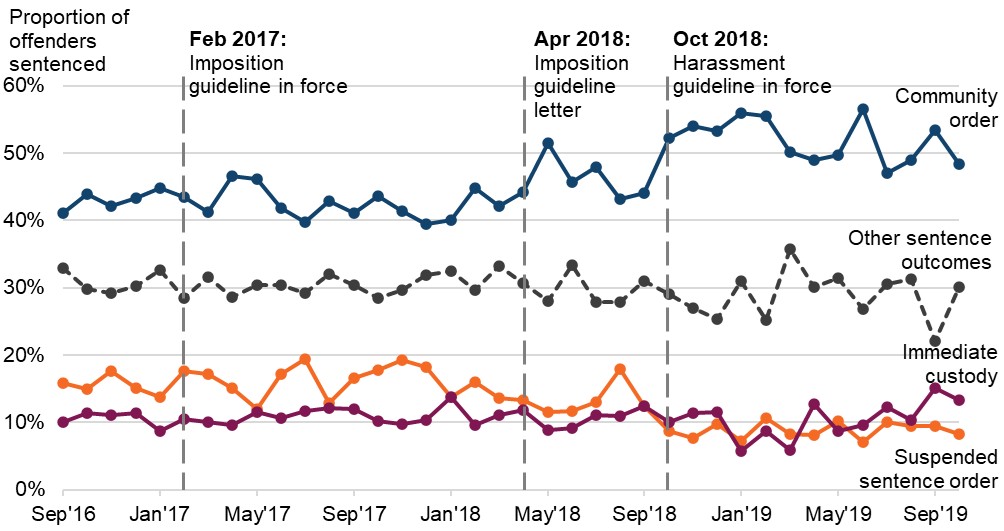
Source: Court Proceedings Database from the Ministry of Justice
While it is not possible to determine how much of the change in sentence outcomes was due to the Imposition guideline letter compared with the Harassment and stalking guideline, there was a clear change following the introduction of the Harassment and stalking guideline. This suggests this guideline contributed to some of the changes in sentencing practice for harassment, which was not anticipated in the resource assessment.
It is also worth noting that the Domestic abuse guideline came into force on 24 May 2018, the same year as the intimidatory offences guidelines came into force and also when the impact of the Imposition guideline was seen. The review of the Domestic abuse guideline found that a higher proportion of sentencers reported increasing the sentence of a harassment case in some way due to the offence being committed in a domestic context following the introduction of the Domestic abuse guideline. However, it should be noted that there were limitations of this analysis (for further information on the analysis and limitations please see section 3.3.5 of the review of the Domestic abuse guideline).
The analysis in this report of sentencing outcomes post guideline for harassment has not indicated an overall increase in the proportion of more severe outcomes (e.g. custody) and a decrease in less severe outcomes (e.g. COs or fines). However, it is possible that the impact of the Imposition guideline and then the Harassment guideline itself has masked any changes resulting from the Domestic abuse guideline. Alternatively, it is possible the proportion of cases which are committed in a domestic context and the changes as a result to the sentence are not substantial enough to see a definitive change in sentencing practice for harassment overall.
Sentence lengths
Another element of sentencing which could be impacted by the guideline is immediate custodial sentence lengths. The proportion of immediate custodial sentences for harassment remained relatively stable over time and these account for a relatively low proportion of sentence outcomes (around 10 to 13 per cent of any given year). However, an analysis of mean and median ACSLs was conducted to examine whether the lengths of immediate custodial sentences changed post guideline (Figure 4).
Figure 4: Average custodial sentence length (ACSL) in months received by adult offenders sentenced for harassment, by year, 2012 to 2022
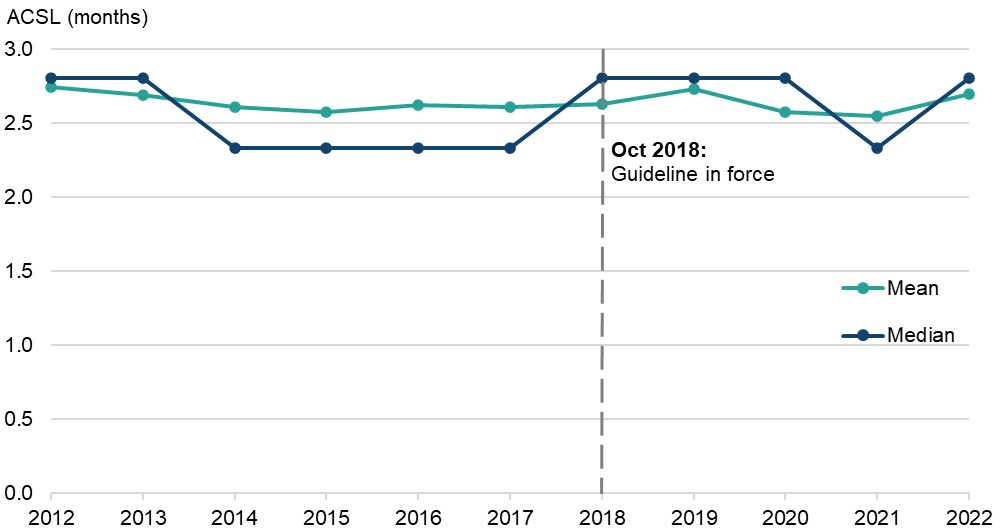
Source: Court Proceedings Database from the Ministry of Justice
Records over the statutory maximum sentence of 6 months were excluded from analysis.
As can be seen, the mean and median ACSLs were relatively stable between 2012 and 2022 (between 2 and 3 months), and no clear changes occurred in the period following the introduction of the guideline. This suggests it did not have an impact on the lengths of immediate custodial sentences issued for harassment, in line with the intimidatory offences resource assessment.
3.1.4 Guideline review
To understand why sentencing practice may have changed following the introduction of the Harassment and stalking guideline, differences between the previous and existing guideline were reviewed.
The MCSG for harassment had a three box sentencing grid, with starting points of a medium level CO, 6 weeks’ custody, and 18 weeks’ custody (Figure 5). The table ranged from a band C fine to 26 weeks’ custody.
Figure 5: The MCSG sentencing table for harassment

Source: Magistrates’ Court Sentencing Guidelines from the National Archive
In contrast, the Harassment and stalking guideline has three levels of culpability and three levels of harm, which produces a nine box sentencing grid (Figure 6). The starting points range from a band B fine to 12 weeks’ custody. The overall sentencing range of the table is from a discharge to 26 weeks’ custody.
Figure 6: The sentencing table from the Harassment and stalking guideline
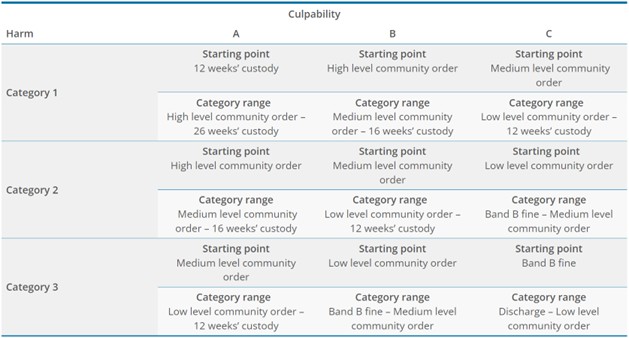
Source: Harassment and stalking guideline from the Sentencing Council website
It is possible the changes in proportions of some disposals are related to the proportion of different starting points in the existing guideline: seven of the nine starting points (78 per cent) are COs, compared with only one of the three starting points (33 per cent) in the previous guideline and there is only one custodial starting point, compared to two in the previous guideline. Additionally, all the category ranges in the existing guideline include COs, compared with two of the three ranges in the MCSG sentencing table.
To explore whether the increase in CO sentencing options has led to the increased proportion of CO sentences observed, the starting points and final sentence outcomes pre and post guideline for harassment cases from the magistrates’ court data collection data were analysed.
3.1.5 Magistrates’ court data collection analysis
The magistrates’ court data collection returned a low response rate (please see section 2.2.2 for information on the data collection methodology and response rates). As seen in Table 4, the sentencing outcome distribution seen in the magistrates’ court data collection broadly reflects the distribution seen in the CPD data (Table 3). This suggests any findings from the data collection analysis can be viewed as broadly representative of overall sentencing seen for this offence. It should be noted the time periods covered by the CPD analysis and the magistrates’ court data collection are slightly different (please see sections 2.2.1 and 2.2.2 for more detailed information on the time periods covered).
Table 4: Proportion of adult offenders sentenced for harassment, by sentence outcome, pre and post guideline
Some shorthand may be used in this table: z = not applicable.
| Sentence outcome | Pre guideline | Post guideline | Percentage point (ppt) difference |
| Absolute or conditional discharge | 12% | 10% | -1 ppt |
| Fine | 21% | 18% | -3 ppts |
| Community order | 38% | 52% | 14 ppts |
| Suspended sentence order | 16% | 7% | -9 ppts |
| Immediate custody | 12% | 11% | -2 ppts |
| Other/unknown | 1% | 1% | 1 ppt |
| Total | 100% | 100% | [z] |
Source: Magistrates’ court data collection from the Sentencing Council
Pre guideline period covers 1 November 2017 to 30 March 2018 (n=225), post guideline period covers 23 April 2019 to 30 September 2019 (n=271). Percentage totals and percentage point differences may not appear to sum correctly due to rounding.
Table 4 shows there was a large increase (14 percentage points) in CO outcomes post guideline, while there was a decrease in both custodial outcomes (9 percentage points for SSOs, 2 percentage points for immediate custody) and fines (3 percentage points).
When looking at the starting points, it can be seen that the 14 percentage point increase in CO outcomes post guideline was not matched by a corresponding increase in CO starting points, of which the proportion only increased by 2 percentage points (Table 5). This small increase in the proportion of CO starting points post guideline is despite there being an increase in CO starting points in the existing guideline (seven out of nine starting points) compared with the MCSG for harassment (one out of three starting points).
Table 5: Proportion of adult offenders sentenced for harassment, by starting point, pre and post guideline
Some shorthand may be used in this table: z = not applicable.
| Starting point | Pre guideline | Post guideline | Percentage point (ppt) difference |
| Absolute or conditional discharge | 2% | 3% | 1 ppt |
| Fine | 6% | 20% | 14 ppts |
| Community order | 58% | 60% | 2 ppts |
| Custody | 31% | 16% | -15 ppts |
| Other/unknown | 3% | 1% | -2 ppts |
| Total | 100% | 100% | [z] |
Source: Magistrates’ court data collection from the Sentencing Council
Pre guideline period covers 1 November 2017 to 30 March 2018 (n=225), post guideline period covers 23 April 2019 to 30 September 2019 (n=271). Percentage totals and percentage point differences may not appear to sum correctly due to rounding.
Table 5 shows that the greatest changes to starting points post guideline were in relation to fines and custodial sentences. Post guideline, there was a 14 percentage point increase in fine starting points (from 6 per cent pre guideline to 20 per cent post guideline). This is likely the result of a fine starting point being available under the Harassment and stalking guideline for the first time, as the previous MCSG for harassment did not include any fine starting points (although a fine was included in the sentence range for the lowest level of seriousness).
Conversely, custodial starting points decreased by 15 percentage points, from 31 per cent pre guideline to 16 per cent post guideline. The decrease in custodial starting points is likely due to the fact that under the new guideline only the most serious offending would receive a custodial starting point, as there is only one custodial starting point under the guideline, which is in category ‘A1’; under the MCSG for harassment two thirds of sentence starting points were custodial.
As stated above, in relation to Figure 6, a possible explanation for the increase in CO outcomes, despite little change in the proportion of starting points is the fact that for most of the CO starting points, the bottom of the sentence range in the guideline includes a CO. This limits the opportunity to reduce the sentence below a CO in all but the very lowest level of cases (under the new guideline, of the seven CO starting points, only two include a range that go below a CO). Pre guideline, under the MCSG, there was only one offence category with a starting point of a CO, and this included a lower sentence range of a band C fine up to a high level CO (HLCO).
As Tables 6 and 7 show, a higher proportion of offenders who received a CO starting point post guideline went on to receive a CO sentence outcome (80 per cent) compared with pre guideline (57 per cent). In addition, there was a decrease post guideline in the proportion of offenders who received a CO starting point who went on to receive a discharge (10 percentage points) or fine (17 percentage points).
The decrease in the proportion of offenders who received a CO starting point, but went onto receive a discharge or fine may explain why the proportion of fine starting points increased, but the proportion of fine outcomes did not. If the proportion of offenders who received a fine outcome (from a CO starting point) has decreased, this may have offset any increase in fine outcomes resulting from the increase in fine starting points.
Table 6: Proportion of adult offenders sentenced for harassment who received each sentence outcome, by starting point, pre guideline
| Starting point | Absolute or conditional discharge | Fine | Community order | Custody | Other/ unknown | Total |
| Fine | 14% | 86% | 0% | 0% | 0% | 100% |
| Community order | 14% | 24% | 57% | 5% | 1% | 100% |
| Custody | 1% | 0% | 16% | 81% | 1% | 100% |
Source: Magistrates’ court data collection from the Sentencing Council
Pre guideline period covers 1 November 2017 to 30 March 2018 (n=225). Absolute or conditional discharge and other/unknown starting points are not included in this table, as the number of offenders who received each was fewer than 10. Percentage totals may not appear to sum correctly due to rounding.
Table 7: Proportion of adult offenders sentenced for harassment who received each sentence outcome, by starting point, post guideline
| Starting point | Absolute or conditional discharge | Fine | Community order | Custody | Other/ unknown | Total |
| Fine | 22% | 65% | 7% | 4% | 2% | 100% |
| Community order | 4% | 7% | 80% | 7% | 1% | 100% |
| Custody | 2% | 2% | 16% | 80% | 0% | 100% |
Source: Magistrates’ court data collection from the Sentencing Council
Post guideline period covers 23 April 2019 to 30 September 2019 (n=271). Absolute or conditional discharge and other/unknown starting points are not included in this table, as the number of offenders who received each was fewer than 10. Percentage totals may not appear to sum correctly due to rounding.
3.2 Stalking
3.2.1 Summary of findings
- A similar change in sentencing practice was seen to have occurred post guideline for stalking as was seen for harassment. There was an increase in the proportion of offenders receiving COs, and a decrease in the proportion of offenders receiving SSOs after the guideline came into force.
- However, there were also some changes to sentencing seen pre guideline, which may have been tied to the Imposition guideline.
- Due to low volumes of returns for the magistrates’ court data collection, more in depth analysis was not possible. However, some of the data indicates that the increase in COs as a final sentence outcome appears to be due to the increased opportunities for receiving a CO starting point under the Harassment and stalking guideline when compared to the previous Magistrates’ Court Sentencing Guideline.
- Overall, it is not possible to determine the degree to which the changes seen were specifically due to the guideline compared with other factors.
- While proportions of immediate custodial sentences remained relatively stable, there was a very slight decrease in ACSLs for stalking across 2018 to 2022. However, it is unclear what may be driving this, and it was concluded the guideline has not impacted custodial sentence lengths.
3.2.2 Background
Stalking was enacted as an offence on 25 November 2012, contrary to section 2A of the Protection from Harassment Act 1997 following an amendment by the Protection of Freedoms Act 2012; it has a statutory maximum sentence of 6 months’ custody, the same as harassment. Prior to the introduction of the Harassment and stalking guideline coming into force on 1 October 2018, there was no previous guideline for this offence. However, there is some evidence, both from research with sentencers at the consultation stage of developing these guidelines and from the magistrates’ court data collection, which suggested that the MCSG guideline for harassment was widely used when sentencing stalking cases.
The intimidatory offences resource assessment estimated that, as with harassment, there would be no impact of the guideline on sentencing outcomes. The intent with the Harassment and stalking guideline was to maintain similar sentencing practice and promote consistency in sentencing. Additionally, whilst stalking and harassment are both covered under the same guideline, the resource assessment anticipated that offenders sentenced for stalking would continue to receive slightly higher sentences than harassment.
3.2.3 Trend analysis
Sentence volumes
The number of offenders sentenced for stalking has broadly increased year on year since the introduction of the offence, with around 880 offenders sentenced in 2022. Volumes appear to have increased in particular from 2016 onwards. It is a summary only offence and, as such, cases are usually sentenced at the magistrates’ courts.
Figure 7: Number of adult offenders sentenced for stalking, by court type, 2012 to 2022
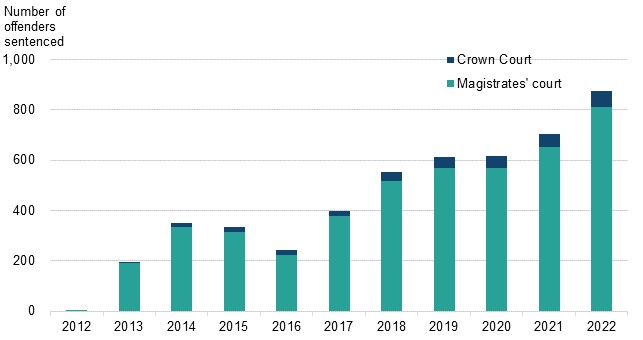
Source: Court Proceedings Database from the Ministry of Justice
Sentence outcomes
Sentence outcomes from the MoJ CPD were analysed, comparing the pre and post guideline periods (Table 8). The changes in sentencing outcomes for offenders sentenced for stalking show a similar pattern to those sentenced for harassment, with an increase in COs (10 percentage points) and a decrease in SSOs post guideline (9 percentage points).
Table 8: Proportion of adult offenders sentenced for stalking, by sentence outcome, pre and post guideline
Some shorthand may be used in this table: z = not applicable, k3 = less than -0.5 percentage point difference.
| Sentence outcome | Pre guideline | Post guideline | Percentage point (ppt) difference |
| Absolute or conditional discharge | 5% | 5% | [k3] |
| Fine | 8% | 6% | -2 ppts |
| Community order | 45% | 55% | 10 ppts |
| Suspended sentence order | 26% | 17% | -9 ppts |
| Immediate custody | 14% | 16% | 2 ppts |
| Other/unknown | 2% | 1% | -1 ppt |
| Total | 100% | 100% | [z] |
Source: Court Proceedings Database from the Ministry of Justice
Pre guideline period covers 1 July 2017 to 30 June 2018 (N=487), post guideline period covers 1 October 2018 to 30 September 2019 (N=595). Percentage totals and percentage point differences may not appear to sum correctly due to rounding.
Furthermore, as with harassment, the trend of an increase in the proportion of COs and decrease in SSOs starts before the guideline comes into force and is maintained beyond the post guideline period (see Figure 8). Given that the offences of stalking and harassment are sentenced using a combined guideline it is not surprising to see a similar pattern of changes in outcomes post guideline.
However, Tables 3 and 8 show both pre guideline and post guideline, stalking is sentenced more severely than harassment. While offenders sentenced for stalking and harassment received similar proportions of COs, a higher proportion of offenders sentenced for stalking received SSOs and immediate custody, while for offenders sentenced for harassment a higher proportion received fines and discharges.
Figure 8: Proportion of adult offenders sentenced for stalking, by sentence outcome, by year, 2013 to 2022

Source: Court Proceedings Database from the Ministry of Justice
Time series excludes the year 2012, due to only 2 offenders being sentenced.
Outcomes for stalking were examined at a more granular level to see whether, as with harassment, the increase in COs and reduction in SSOs may have been influenced by the introduction of the Imposition guideline, or subsequent communication to reinforce it. The data in Figure 9 is grouped by quarter to provide a more robust comparison between time periods, due to the low volume of offenders sentenced each month for stalking.
In quarter 1 (Q1) 2017 – when the Imposition guideline was published – an increase in COs and decrease an SSOs can be seen, although this fluctuates in the following quarters. There then appears to be no clear evidence of an impact related to the publication of the Imposition guideline letter in April 2018 for stalking, as the proportion of SSOs and COs issued remain stable across Q2 and Q3 2018. Instead, an increase in proportion of COs and decrease in SSOs are seen following the Harassment and stalking guideline coming into force in October 2018 (Q4 2018) before generally stabilising by the end of 2019.
Overall, while changes were seen following the Harassment and stalking guideline coming into force, it is unclear whether this was part of a continuation of an existing trend seen from Q3 2016 onwards. Therefore, it is not possible to determine from this CPD analysis, whether the guideline contributed to the increase in proportion of COs and decrease in proportion of SSOs, or whether the changes seen were likely due to the Imposition guideline or another other factor.
Figure 9: Proportion of adult offenders sentenced for stalking, by sentence outcome, by quarter, July 2016 to December 2019
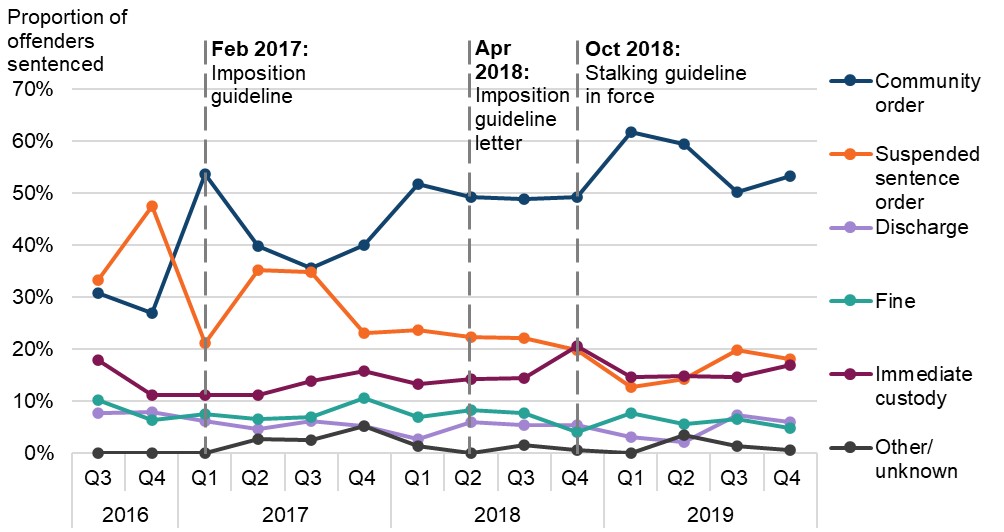
Source: Court Proceedings Database from the Ministry of Justice
Quarter 1 (Q1) covers January to March, Q2 covers April to June, Q3 covers July to September, and Q4 covers October to December.
Sentence lengths
In addition to sentencing outcomes being considered, changes to sentence lengths issued for immediate custodial sentences are shown in Figure 10. The data suggests that the ACSLs between 2013 and 2022 remained relatively stable, other than a small increase in median ACSL in 2017 which immediately dropped again in 2018. There has been a very slight decrease in ACSL over time, but it is not clear whether this is guideline related, as the decrease appears to be part of a longer term trend, rather than focused around 2018 and 2019, when we would expect the biggest impact to be apparent if it was tied to the guideline.
Figure 10: Average custodial sentence length (ACSL) in months received by adult offenders sentenced for stalking, by year, 2013 to 2022
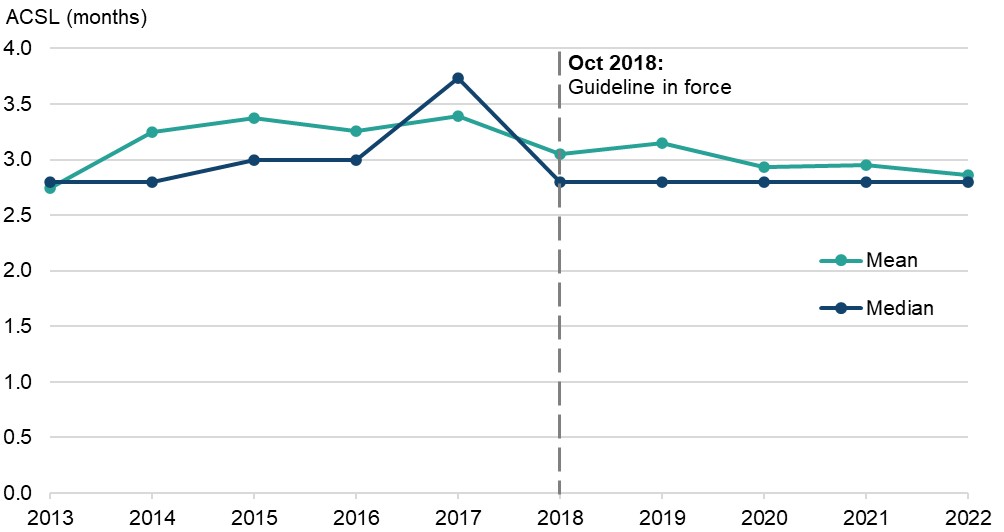
Source: Court Proceedings Database from the Ministry of Justice
Records over the statutory maximum sentence of 6 months were excluded from analysis. Data is presented from 2013 as no offenders were sentenced to immediate custody for stalking in 2012.
3.2.4 Magistrates’ court data collection analysis
The data collection for stalking returned a relatively low response rate and as the number of records collected pre guideline is fewer than 30, caution needs to be taken when interpreting these figures. As a result of the low volumes, in depth analysis of the data has not been possible.
Table 9 shows the proportion of sentence outcomes pre and post guideline from the data collection for offenders sentenced for stalking. This broadly reflects the sentencing changes seen in the CPD, of an increase in COs and a decrease in SSOs, although in the CPD data (Table 8) the increase in COs post guideline is more prominent (a 10 percentage point increase, rather than 5).
Table 9: Proportion of adult offenders sentenced for stalking, by sentence outcome, pre and post guideline
Some shorthand may be used in this table: z = not applicable.
| Sentence outcome | Pre guideline | Post guideline | Percentage point (ppt) difference |
| Absolute or conditional discharge | 4% | 2% | -2 ppts |
| Fine | 4% | 7% | 3 ppts |
| Community order | 44% | 49% | 5 ppts |
| Suspended sentence order | 26% | 18% | -8 ppts |
| Immediate custody | 22% | 25% | 2 ppts |
| Other/unknown | 0% | 0% | 0 ppts |
| Total | 100% | 100% | [z] |
Source: Magistrates’ court data collection from the Sentencing Council
Pre guideline period covers 1 November 2017 to 30 March 2018 (n=27), post guideline period covers 23 April 2019 to 30 September 2019 (n=61). Percentage totals and percentage point differences may not appear to sum correctly due to rounding.
Table 10 examines the proportion of offenders sentenced for stalking by the starting point received. Unlike harassment, a much higher proportion of offenders received a CO starting point post guideline than pre guideline; however, the pre guideline proportions are based on a low sample, so care should be taken when interpreting the figures.
Table 10: Proportion of adult offenders sentenced for stalking, by starting point, pre and post guideline
Some shorthand may be used in this table: z = not applicable.
| Starting point | Pre guideline | Post guideline | Percentage point (ppt) difference |
| Absolute or conditional discharge | 0% | 2% | 2 ppts |
| Fine | 4% | 2% | -2 ppts |
| Community order | 48% | 61% | 13 ppts |
| Custody | 41% | 34% | -6 ppts |
| Other/unknown | 7% | 2% | -6 ppts |
| Total | 100% | 100% | [z] |
Source: Magistrates’ court data collection from the Sentencing Council
Pre guideline period covers 1 November 2017 to 30 March 2018 (n=27), post guideline period covers 23 April 2019 to 30 September 2019 (n=61). Percentage totals and percentage point differences may not appear to sum correctly due to rounding.
The increase in offenders receiving a CO outcome (Table 9) may therefore be due to more cases receiving a COs as a starting point (Table 10); this may be tied to the increase in CO starting points in the Harassment and stalking guideline (seven out of nine starting points) compared with the MCSG for harassment (one out of three starting points).
Overall, while the data are not robust enough to draw firm conclusions, this suggests the guideline may have led to some of the changes observed in sentencing practice. No analysis to examine the decrease in SSOs has been possible with the data collection data, due to low volumes.
3.3 Harassment (putting people in fear of violence)
3.3.1 Summary of findings
- For the offence of harassment (putting people in fear of violence) there was an overall increase in the proportion of COs, and a decrease in the proportion of SSOs issued from 2018. However, the proportions of sentence outcomes in 2022 reverted back to a similar distribution seen pre guideline.
- The changes to the proportion of COs and SSOs appear to have started when the Imposition guideline letter was published in April 2018, before the Harassment and stalking (fear of violence) guideline came into force.
- Proportions of immediate custodial sentences remained similar pre and post guideline. However, there was a slow and steady increase in ACSL until 2022, which suggests the increase was not tied to the introduction of the guideline. It was also concluded that it was not related to the increase to the statutory maximum sentence which increased from 5 years’ custody to 10 years’ custody on 3 April 2017, as any changes relating to these would have been expected to be seen in 2018 and 2019, before levelling off.
- It therefore appears that the Harassment and stalking (fear of violence) guideline has not had a clear impact on sentencing outcomes or increasing sentence lengths for immediate custodial sentences, which is in line with the intention stated in the resource assessment.
3.3.2 Background
The offence of harassment (putting people in fear of violence) is contrary to section 4 of the Protection from Harassment Act. For brevity, the offence will be referred to as harassment (fear of violence) hereafter. This offence had a statutory maximum sentence of 5 years’ custody until 2 April 2017, and from 3 April 2017 this increased to 10 years’ custody. To account for this the Harassment and stalking (fear of violence) guideline included a new ‘very high culpability’ level. The only opportunity for sentencers to arrive at a sentence greater than 5 years’ custody is contained within one box, ‘A1’, which has a starting point of 5 years’ custody.
Prior to the Harassment and stalking (fear of violence) guideline coming into force on 1 October 2018, there was a MCSG for harassment (fear of violence) which had been in force from 4 August 2008. However, this was only applicable for cases sentenced at the magistrates’ courts.
For the offence of harassment (fear of violence) the resource assessment stated that no impact was expected as a result of the introduction of the guideline, as sentencing levels were set with current sentencing practice in mind. As the statutory maximum sentence for this offence increased from 5 to 10 years’ custody as of 3 April 2017, the resource assessment suggested a small number of offenders falling into the highest category of seriousness may receive higher sentences. However, this would be attributable to the legislative change, rather than the guideline.
3.3.3 Trend analysis
Sentence volumes
Since 2012, the number of offenders sentenced for harassment (fear of violence) have fluctuated; however over the past 5 years, it has remained at approximately 500 to 600 each year (Figure 11).
The proportion of offenders sentenced in the magistrates’ courts and Crown Court each year are broadly evenly split. There appear to be no changes in the proportion of offenders sentenced at the magistrates’ courts relating to the introduction of the Harassment and stalking (fear of violence) guideline.
Figure 11: Number of adult offenders sentenced for harassment (fear of violence), by court type, 2012 to 2022
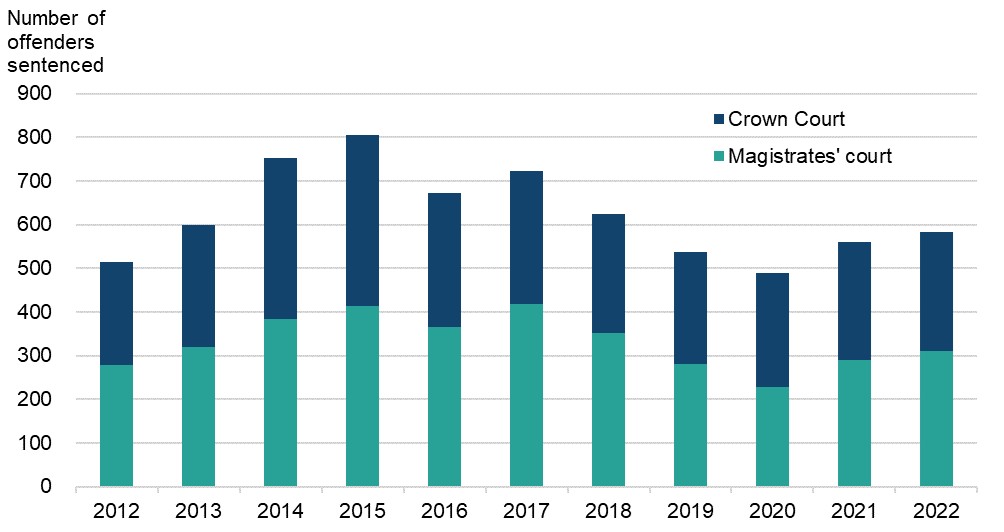
Source: Court Proceedings Database from the Ministry of Justice
Sentence outcomes
Analysis comparing sentence outcomes indicates that the proportion of offenders sentenced for harassment (fear of violence) who received a CO increased by 6 percentage points post guideline, while the proportion of those who received a SSO decreased by 8 percentage points (Table 11). This follows a similar pattern in changes to sentencing practice post guideline as has been seen with harassment and stalking. The use of other sentence outcomes remained relatively stable over this period, including immediate custodial sentences which are the most common sentence outcome for this offence (around 38 per cent both pre and post guideline).
Table 11: Proportion of adult offenders sentenced for harassment (fear of violence), by sentence outcome, pre and post guideline
Some shorthand may be used in this table: z = not applicable, k3 = less than -0.5 percentage point difference.
| Sentence outcome | Pre guideline | Post guideline | Percentage point (ppt) difference |
| Absolute or conditional discharge | 1% | 2% | 1 ppt |
| Fine | 1% | 2% | 2 ppts |
| Community order | 22% | 28% | 6 ppts |
| Suspended sentence order | 37% | 29% | -8 ppts |
| Immediate custody | 38% | 38% | -1 ppt |
| Other/unknown | 1% | 1% | [k3] |
| Total | 100% | 100% | [z] |
Source: Court Proceedings Database from the Ministry of Justice
Pre guideline period covers 1 July 2017 to 30 June 2018 (N=694), post guideline period covers 1 October 2018 to 30 September 2019 (N=543). Percentage totals and percentage point differences may not appear to sum correctly due to rounding.
However, when examining the sentence outcomes across 2012 to 2022 (Figure 12), the changes following the period immediately after the guideline was introduced were not maintained over time. For example, while post guideline, COs increased to around 28 per cent (Table 11), by 2022, around 22 per cent of offenders sentenced for harassment (fear of violence) received a CO, which is more in line with figures seen pre guideline in 2017 (Figure 12). Furthermore, the decrease seen in SSOs to around 29 per cent of offenders sentenced post guideline, returned to 36 per cent in 2022, which is again back in line with figures seen before the guideline came into force.
It would not be expected that the Harassment and stalking (fear of violence) guideline would only have had a short-term impact. This therefore suggests that either a different factor led to the changes seen in 2018 to 2020 instead of the guideline, or alternatively the guideline did have an impact in 2018, but a separate factor reversed these changes across 2021 and 2022.
Figure 12: Proportion of adult offenders sentenced for harassment (fear of violence), by sentence outcome, 2012 to 2022
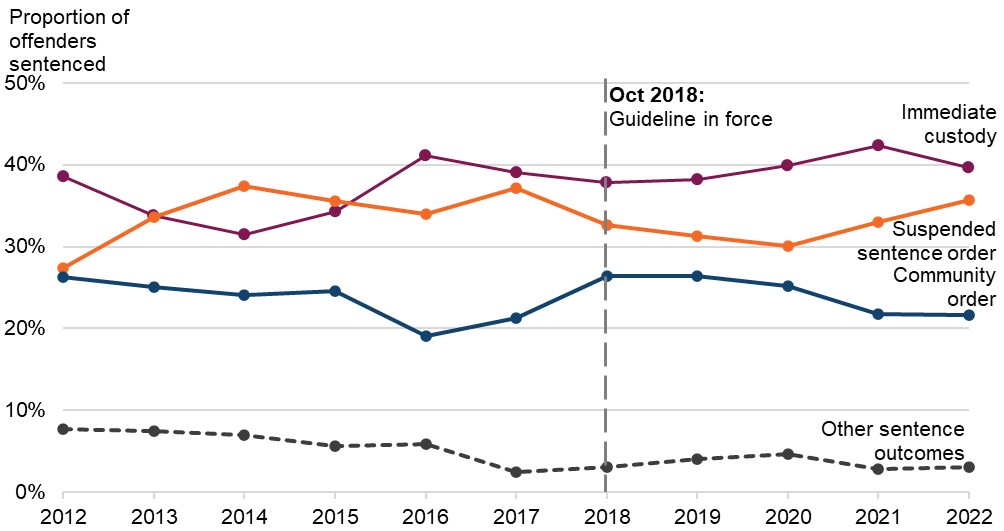
Source: Court Proceedings Database from the Ministry of Justice
As with the offences of harassment and stalking, it is possible that the Imposition guideline or associated letter to sentencers played a role in affecting sentencing outcomes. Figure 13 shows the sentence outcomes for harassment (fear of violence) split by quarter rather than month, due to low monthly volumes.
Figure 13: Proportion of adult offenders sentenced for harassment (fear of violence), by outcome, by quarter, July 2016 to December 2019
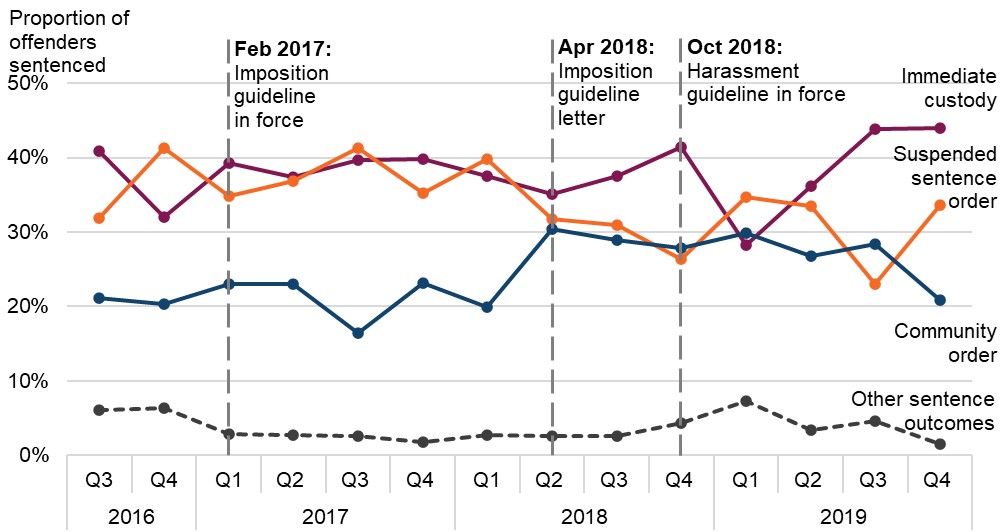
Source: Court Proceedings Database from the Ministry of Justice
Quarter 1 (Q1) covers January to March, Q2 covers April to June, Q3 covers July to September, and Q4 covers October to December.
As can be seen in Figure 13, the proportion of SSOs issued started to decrease in Q2 2018 which aligns with the time the letter was sent regarding the Imposition guideline, and this decrease continued until the Harassment and stalking (fear of violence) guideline came into force in Q4 2018. The proportion of SSOs stayed broadly at a lower level than was seen before the publication of the Imposition guideline letter. The picture is the reverse for COs, which clearly increased in Q2 2018, when the Imposition guideline letter was published; this level was then broadly maintained over the period that the Harassment and stalking (fear of violence) guideline came into force.
This suggests that the publication of the Imposition letter may have had the greater impact on sentence outcomes, and the introduction of the Harassment and stalking (fear of violence) guideline may have had very little effect on the CO outcomes, and possibly a limited effect on the proportion of SSOs.
Sentence lengths
As the statutory maximum sentence for this offence increased from 5 years’ custody to 10 years’ custody from 3 April 2017, the ACSL was likely to increase as a result. Any changes to the ACSL were expected to result from the legislative change, rather than as a result of the guideline.
As seen in Figure 14, the mean ACSL increased slightly from 2016 to 2017, when this legislative change came into force, from approximately 10 months to 11 months, and a very gradual upward trend has continued since. In 2022, the mean ACSL was approximately 14 months, an increase of 4 months compared with 2016 before the statutory maximum sentence increase was in force. There is no evidence of a notable shift when the Harassment and stalking (fear of violence) guideline came into force in 2018, but an increase is seen in 2019 which could be tied to the guideline. However, the ACSL continues to gradually increase through to 2022, suggesting changes may be related to something other than the guideline. If there was an impact of the guideline alone, changes would be expected to be seen in 2018 and 2019 before remaining stable thereafter.
Figure 14: Average custodial sentence length (ACSL) in months received by adult offenders sentenced for harassment (fear of violence), by year, 2012 to 2022
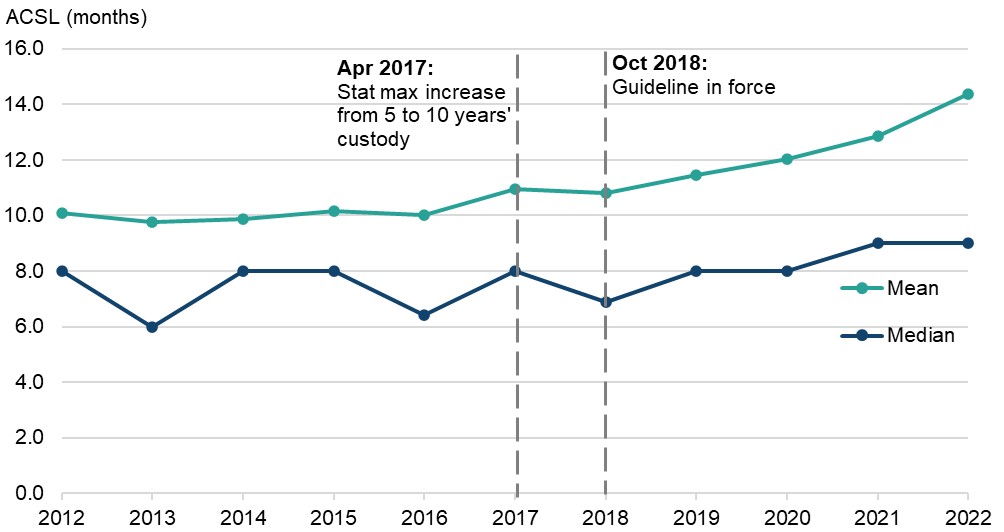
Source: Court Proceedings Database from the Ministry of Justice
One offender in 2012 was excluded, as they received an indeterminate sentence.
Figure 15 examines the proportion of offenders given immediate custodial sentences by sentence length for the offence of harassment (fear of violence). It is important to note that due to the time between an offence being committed and sentenced, offences committed before the statutory maximum sentence change in April 2017 would still likely be in the system to be sentenced in the months following April, and these would have been sentenced under the previous statutory maximum sentence of 5 years’ custody. Only cases which were both committed on or after 3 April 2017 and were sentenced before 31 December 2017 would be sentenced under the 10 years’ custody statutory maximum sentence in 2017. Data from the Criminal Court Statistics Quarterly October to December 2023 end-to-end timeliness tool indicates that in 2017 the average number of days (median) from offence to completion for offenders dealt with in criminal cases at the Crown Court was 234 days (approximately 8 months). The effects of this statutory maximum sentence change likely therefore continue into 2018, where an increasing proportion of harassment (fear of violence) cases would have been processed under the new statutory maximum sentence. This makes it difficult to determine whether any changes seen in 2018 would be due to the continuing effects of the statutory maximum sentence change, or also due to an impact resulting from the Harassment and stalking (fear of violence) guideline coming into force.
Figure 15: Proportion of offenders sentenced to immediate custody for harassment (fear of violence), by sentence length, by year, 2012 to 2022
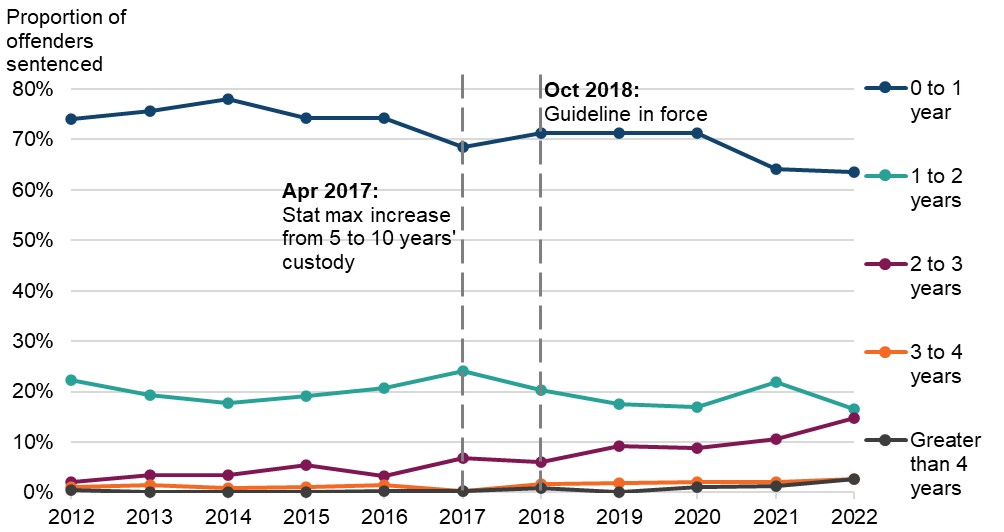
Source: Court Proceedings Database from the Ministry of Justice
One offender in 2012 was excluded, as they received an indeterminate sentence.
Comparing 2017 (when the statutory maximum sentence increased from 5 to 10 years’ custody) with the year prior, sentences of up to and including 1 year decreased slightly by 6 percentage points, and there was a corresponding increase in sentences of 1 to 2 years (3 percentage points) and 2 to 3 years (3 percentage points). However, offenders receiving sentences of 3 years or more remained broadly stable.
In later years, from 2018 and beyond, the proportion of offenders receiving 2 or more years increased. These changes were particularly clear in 2021 and 2022 when offenders were receiving custodial sentences longer than 5 years for the first time. However, it is unclear what may have led to the increase in sentencing severity, as it may be expected that any changes resulting from the statutory maximum sentence change and introduction of the Harassment and stalking (fear of violence) guideline would be seen in 2017 to 2018 and then remain consistent in the proceeding years.
3.3.4 Guideline review
To understand what changes, if any, were driven by the Harassment and stalking guideline coming into force on 1 October 2018, differences between this guideline and the previous MCSG guideline were examined.
The MCSG guideline had a three-box sentencing grid, with the starting points at: 6 weeks’ custody; 18 weeks’ custody; and any cases reaching the most serious nature of activity would be sent to the Crown Court (Figure 16).
Figure 16: The sentencing table from the MCSG for harassment (fear of violence)

Source: Magistrates’ Court Sentencing Guidelines from the National Archive
In contrast, the Harassment and stalking (fear of violence) guideline has a 12-box sentencing grid with four levels of culpability and three levels of harm (Figure 17). Of the starting points, 75 per cent are custodial (nine out of 12), and the remaining 25 per cent (three out of 12) are COs. The table ranges from a band C fine to 8 years’ custody.
Figure 17: The sentencing table from the Harassment and stalking (fear of violence) guideline
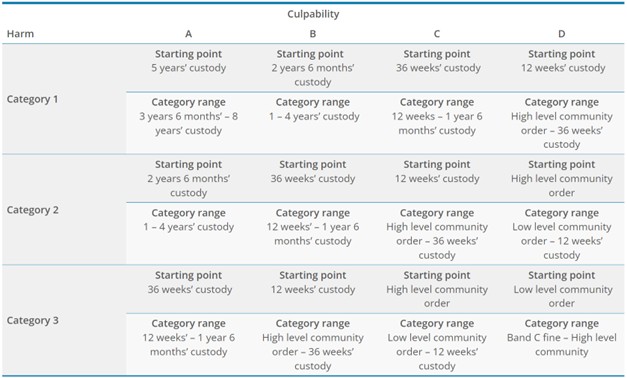
Source: Harassment and stalking (fear of violence) guideline from the Sentencing Council website
In the pre guideline period, as shown in Table 11, approximately 22 per cent of offenders pre guideline received COs. The MCSG sentencing table included COs only in the bottom range of the lowest ‘seriousness’ category and contained no CO starting points. The increased availability of CO starting points in the Harassment and stalking (fear of violence) guideline sentencing table does not appear to have led to the increase in the proportion of COs being issued as final sentence outcomes (28 per cent in the post guideline period). Instead, Figure 13 shows that the increase in COs final sentence outcomes may be related to the publication of the Imposition letter instead.
3.3.5 Transcript analysis
A small sample of 14 Crown Court transcripts from 2019 and 2020 were examined to explore whether there were any implementation issues with the Harassment and stalking (fear of violence) guideline. The transcripts were not representative of all offending, but instead were specifically sampled to include cases receiving the highest immediate custodial sentence lengths. The cases receiving the highest sentences were of particular interest given how few cases have received a sentence of 5 years’ custody or higher, despite the statutory maximum sentence doubling from 5 to 10 years’ custody. These cases have been examined to review whether the guideline is working as intended, in particular whether the ‘A – Very high culpability’ category is capturing the expected cases.
Of the 14 transcripts included, nine cases were those receiving the longest custodial outcomes for 2020. A review of these cases showed that the majority of these (five out of nine) fell into the ‘A1’ category, the highest culpability and harm categories (determined either by what was stated by the sentencer or inferred based on the starting point, if not explicitly stated by the sentencer). The remaining four cases fell into ‘A2’ and ‘B1’ categories. Based on the factors and information stated by the sentencer, there was no evidence to suggest that these cases were miscategorised during sentencing. This suggests the reason sentence lengths have not increased more (Figure 15), or that there have not been sentences for this offence over 5 years’ custody, is not due to the guideline criteria preventing cases from falling into category ‘A1’.
Within the five cases falling into ‘A1’, the starting point was usually 5 years’ custody as stated in the guideline. Following any aggravation and mitigation, and application of any guilty plea reduction, all cases resulted in a final sentence of under 5 years’ custody. This indicates that for a case to end up with a sentence of over 5 years, it would have to be sentenced after a trial (no guilty plea reduction) in combination with aggravation being applied. For example, theoretically, even if a case increased from the starting point of 5 years’ custody to the top of the sentencing range of 8 years’ custody, after applying a guilty plea reduction of 33 per cent, the case would only just end up with a final sentence of over 5 years.
Additionally, two successful court of appeal transcripts from 2022 were reviewed for this offence, but neither transcript suggested any issues in use of the guideline.
3.4 Stalking (involving fear of violence or serious alarm or distress)
3.4.1 Summary of findings
- There has been an increase in immediate custodial sentences and a decrease in the proportion of SSOs issued post guideline for the offence of stalking (involving fear of violence or serious alarm). However, these changes may be related to the introduction of the Imposition guideline in February 2017, rather than the Harassment and stalking (fear of violence) guideline, as no changes were seen immediately after it came into force.
- The ACSL increased in 2018 and 2019 and then stabilised across 2020 to 2022. This increase may be related to the slight increases in the proportion of cases seen before the Crown Court and the increase in offenders receiving custodial sentences of greater than 1 year.
- There has been an increase in sentence lengths across the board, rather than just at the very top end as anticipated in the resource assessment. However, it is not possible to determine how much of this impact is due to the guideline versus the change in statutory maximum sentence, which increased from 5 years’ custody to 10 years’ custody from 3 April 2017.
3.4.2 Background
Stalking (involving fear of violence or serious alarm or distress) was enacted as an offence on 25 November 2012, contrary to section 4A of the Protection from Harassment Act 1997 following an amendment by the Protection of Freedoms Act 2012. This offence will be referred to as stalking (fear of violence) hereafter. As with harassment (fear of violence), this offence had a statutory maximum sentence of 5 years’ custody until 2 April 2017, after which it increased to 10 years’ custody.
Prior to the introduction of the Harassment and stalking (fear of violence) guideline, no guidelines were available for use by sentencers for stalking (fear of violence).
The intimidatory offences resource assessment anticipated that the Harassment and stalking (fear of violence) guideline covering the offence of stalking (fear of violence) would have no impact on average sentencing severity for most cases. The guideline was intended to maintain similar sentencing practice. Nevertheless, it was also expected that a small number of offenders falling into the highest culpability and harm box would receive a higher sentence, to reflect the increase in statutory maximum sentence.
3.4.3 Trend analysis
Sentence volumes
Following the introduction of stalking (fear of violence) in 2012 as an offence, volumes of offenders sentenced for this offence have generally increased year on year, including across the period the guideline came into force. In 2022, around 810 offenders were sentenced, an increase of around 250 offenders from the previous year.
The proportion of offenders sentenced in the Crown Court ranged from 50 to 56 per cent across 2014 to 2018. This then increased from 2019 onwards to between 60 to 66 per cent.
Figure 18: Number of adult offenders sentenced for stalking (fear of violence), by court type, 2012 to 2022
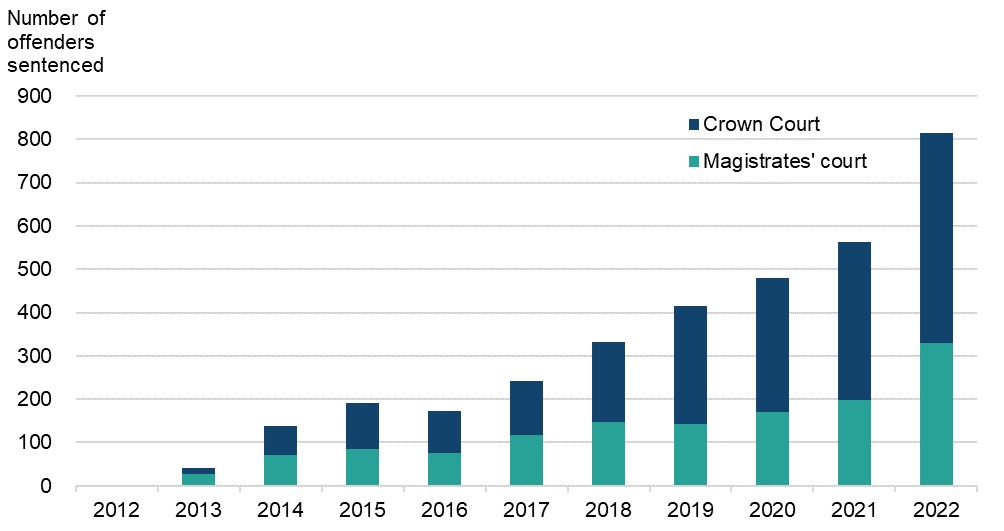
Source: Court Proceedings Database from the Ministry of Justice
Sentence outcomes
When examining trends pre and post guideline, Table 12 indicates no meaningful changes in the proportion of sentence outcomes.
Table 12: Proportion of adult offenders sentenced for stalking (fear of violence), by sentence outcome, pre and post guideline
Some shorthand may be used in this table: z = not applicable, k1 = less than 0.5 per cent, k2 = less than 0.5 percentage point difference, k3 = less than -0.5 percentage point difference.
| Sentence outcome | Pre guideline | Post guideline | Percentage point (ppt) difference |
| Absolute or conditional discharge | [k1] | [k1] | [k3] |
| Fine | 1% | 1% | [k2] |
| Community order | 17% | 18% | [k2] |
| Suspended sentence order | 36% | 35% | -1 ppt |
| Immediate custody | 45% | 45% | [k2] |
| Other/unknown | 1% | 1% | [k3] |
| Total | 100% | 100% | [z] |
Source: Court Proceedings Database from the Ministry of Justice
Pre guideline period covers 1 July 2017 to 30 June 2018 (N=284), post guideline period covers 1 October 2018 to 30 September 2019 (N=384). Percentage totals and percentage point differences may not appear to sum correctly due to rounding.
While the pre and post guideline comparisons in Table 12 show no real change in the proportions of SSOs and immediate custody, Figure 19 shows an overall decrease in SSOs between 2015 to 2020, with a large decrease in SSOs from 2017 to 2018, which then remains broadly stable until 2020. However, in 2021 and 2022, the proportion of SSOs increases again to levels seen before the introduction of the Harassment and stalking (fear of violence) guideline. The longer term trend also appears to suggest an increase in immediate custodial sentences between 2013 and 2022. In addition, although Table 12 indicates a very slight increase pre and post guideline in COs, the overall trend was one of slight decreases between 2013 and 2022.
Figure 19: Proportion of adult offenders sentenced for stalking (fear of violence) by outcome, by year, 2013 to 2022
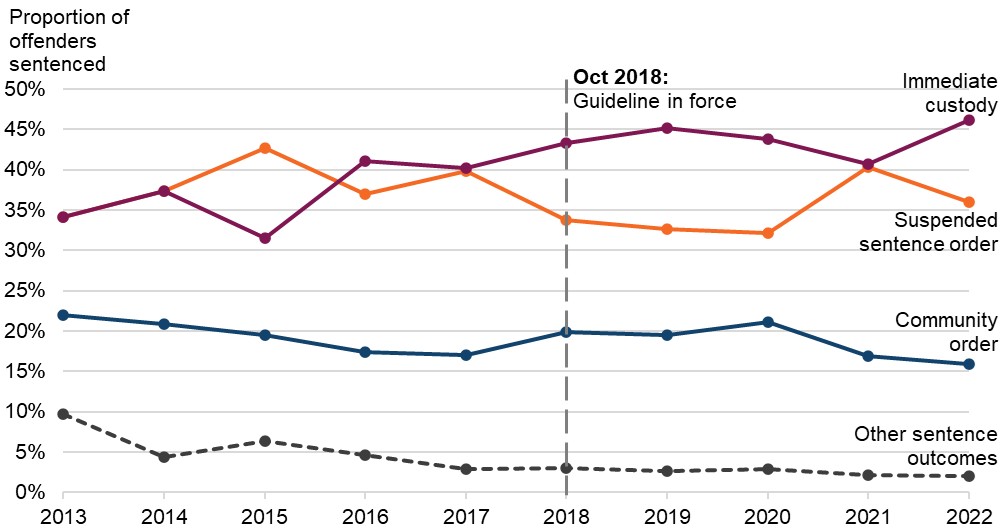
Source: Court Proceedings Database from the Ministry of Justice
The time series excludes 2012, as no offenders were sentenced for stalking (fear of violence).
As with the previous offences, the change in sentence outcomes seen in Figure 19 has been examined at a quarterly level to review precisely when changes occurred and whether these align with the introduction of the guideline. It is important to note that in Figure 20, the volumes of data in each quarter are relatively low, which may explain the fluctuations seen in proportions of sentence outcomes. For instance, the volumes per quarter in 2017 were around approximately 50 to 70 offenders.
Figure 20 demonstrates that the decrease seen in SSOs, from 2017 to 2018 in Figure 19, appears to have happened following the introduction of the Imposition guideline in 2017, although this trend reverses again following the publication of the Imposition guideline letter. Due to the low volumes and quarter on quarter fluctuations in the proportion of offenders receiving SSOs and immediate custodial sentences across the time period, there is no clear evidence that these trends are related to the impact of the Harassment and stalking (fear of violence) guideline coming into force.
Figure 20: Proportion of adult offenders sentenced for stalking (fear of violence), by outcome, by quarter, July 2016 to December 2019
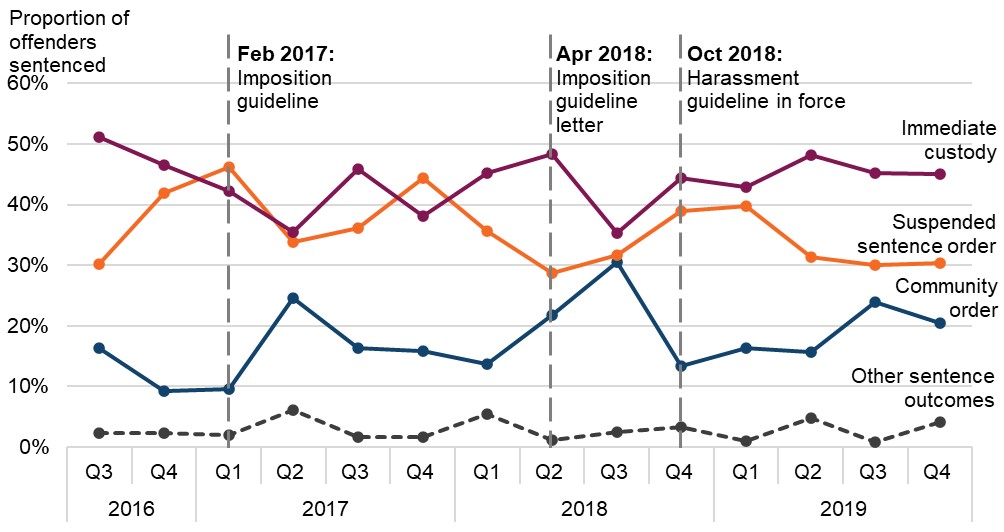
Source: Court Proceedings Database from the Ministry of Justice
Quarter 1 (Q1) covers January to March, Q2 covers April to June, Q3 covers July to September, and Q4 covers October to December.
Sentence lengths
Changes seen in sentence lengths following the introduction of the guideline were also examined in Figure 21 which shows the ACSL for immediate custodial sentences for stalking (fear of violence). In 2018 a notable increase in mean ACSL can be seen compared with 2017, which further increases in 2019 before remaining broadly stable in the following years.
Figure 21: Average custodial sentence length (ACSL) in months for stalking (fear of violence), by year, 2013 to 2022
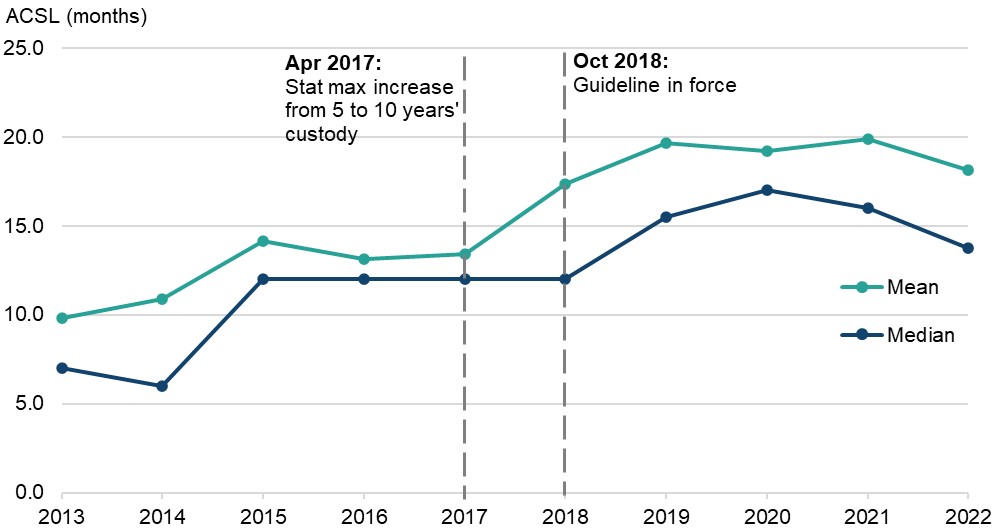
Source: Court Proceedings Database from the Ministry of Justice
The time series excludes 2012, as no offenders were sentenced for stalking (fear of violence).
It is important to note that while the statutory maximum sentence increased in April 2017, the time between an offence being committed and sentenced means that there may have been a delay in cases being sentenced under the new statutory maximum sentence showing in the data. For example, it’s possible that the finding of no substantial change in ACSL in 2017 may reflect the fact that very few cases were sentenced in 2017 which were subject to the higher statutory maximum sentence. Offences committed before the statutory maximum sentence change in April would likely still be in the system to be sentenced in the months following April and instead would have been sentenced under the previous statutory maximum sentence (5 years’ custody).
The resource assessment stated only cases falling into the most serious harm and culpability categories would be expected to receive a higher sentence than before the statutory maximum sentence change. Comparing specifically the ACSL in the pre guideline period with the post guideline period, a clear increase is seen for stalking (fear of violence) (Table 13). Pre guideline, the mean ACSL was 15 months, and this increased by 5 months on average post guideline to 20 months. It is interesting to note that while the change in statutory maximum sentence was the same for both harassment (fear of violence) and stalking (fear of violence) and both are covered by the same guideline, the change in ACSL is much more prominent for stalking (fear of violence).
Table 13: Average custodial sentence length (ACSL) in months, pre and post guideline, by offence
| ACSL (months) | Pre guideline stalking | Post guideline stalking | Pre guideline harassment | Post guideline harassment |
| Mean | 15 | 20 | 11 | 12 |
| Median | 12 | 15 | 8 | 7 |
Source: Court Proceedings Database from the Ministry of Justice
Pre guideline period covers 1 July 2017 to 30 June 2018 (stalking, N=127; harassment, N=265), post guideline period covers 1 October 2018 to 30 September 2019 (stalking, N=173; harassment, N=204)
Note: Stalking refers to the offence of stalking (fear of violence), and harassment refers to the offence of harassment (fear of violence).
Both pre and post guideline stalking (fear of violence) cases receive more severe sentences than harassment (fear of violence) both in terms of sentence length (Table 13) and sentence outcome (Table 14). One possible explanation for why the ACSL for harassment (fear of violence) had a modest increase post guideline while the stalking (fear of violence) ACSL increased to a greater extent is that fewer harassment (fear of violence) cases may have fallen into the highest threshold for culpability and harm which was set to reflect the increased statutory maximum sentence, meaning that there were fewer cases with the higher sentence lengths.
Table 14: Comparison of stalking (fear of violence) and harassment (fear of violence), by sentence outcome, pre and post guideline
Some shorthand may be used in this table: k1 = less than 0.5 per cent, k2 = less than 0.5 percentage point difference, k3 = less than -0.5 percentage point difference.
| Sentence outcome | Pre guideline stalking | Post guideline stalking | Pre guideline harassment | Post guideline harassment |
| Absolute or conditional discharge | [k1] | [k1] | 1% | 2% |
| Fine | 1% | 1% | 1% | 2% |
| Community order | 17% | 18% | 22% | 28% |
| Suspended sentence order | 36% | 35% | 37% | 29% |
| Immediate custody | 45% | 45% | 38% | 38% |
| Other/unknown | 1% | 1% | 1% | 1% |
| Total | 100% | 100% | 100% | 100% |
Source: Court Proceedings Database from the Ministry of Justice
Pre guideline period covers 1 July 2017 to 30 June 2018 (stalking, N=284; harassment, N=694), post guideline period covers 1 October 2018 to 30 September 2019 (stalking, N=384; harassment, N=543)
Note: Stalking refers to the offence of stalking (fear of violence), and harassment refers to the offence of harassment (fear of violence). Percentage totals may not appear to sum correctly due to rounding.
Figure 22 includes a breakdown of sentence lengths for offenders sentenced to immediate custody for stalking (fear of violence) after application of any guilty plea, to review whether the increase in sentence lengths for stalking (fear of violence) is driven by increases across the board, or if these increases are confined to the cases at the upper end of the sentencing scale as stated in the resource assessment. In box ‘A1’, where the most severe offending would fall, the starting point is 5 years’ custody with a range of 3 years 6 months’ custody to 8 years’ custody. Any starting points and ranges stated in the guideline are before any guilty plea reduction has been applied.
Figure 22: Proportion of offenders sentenced to immediate custody for stalking (fear of violence), by sentence length, by year, 2013 to 2022
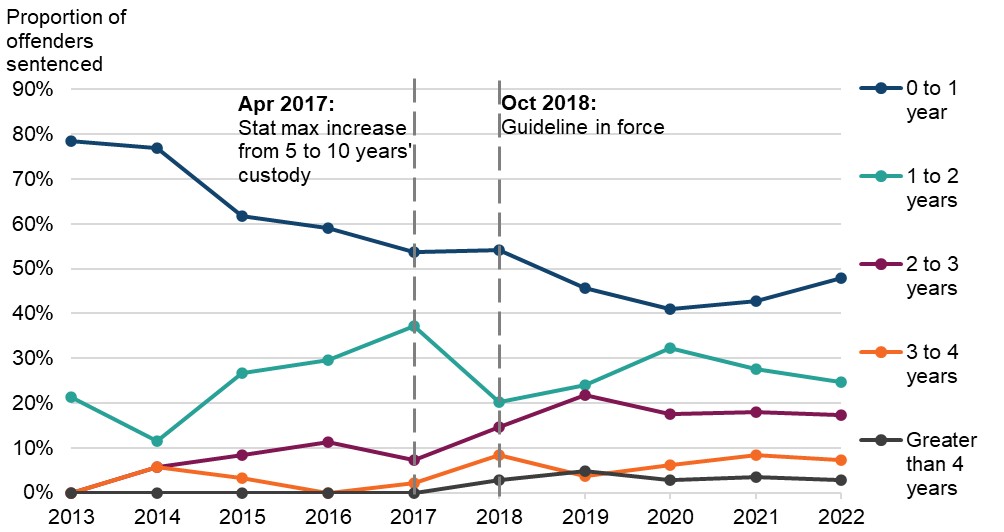
Source: Court Proceedings Database from the Ministry of Justice
The time series excludes 2012, as no offenders were sentenced for stalking (fear of violence).
Across 2013 to 2017 no offenders were sentenced to greater than 4 years’ custody. In 2018, around 3 per cent of offenders received a sentence of greater than 4 years’ custody and a small proportion of offenders beyond 2018 continued to receive sentence lengths of greater than 4 years’ custody (between 3 to 5 per cent on any given year). This demonstrates some increase in the proportion of offenders receiving sentences at the upper end.
However, there were also increases across the 2 to 3 years’ custody length band. There also appears to have been a reduction in shorter custodial sentences. For example, in 2017, around 91 per cent of offenders received up to 2 years’ custody. In 2018, this was much lower at 74 per cent of offenders.
If only the most serious offending (by a small number of offenders) was due to be affected by the statutory maximum sentence change, and there was envisioned to be no effect of the guideline in increasing sentencing severity otherwise, then it would be expected that cases at the lower end of sentencing (e.g., up to 2 years’ custody) would have remained relatively unchanged, rather than decreasing. This suggests there has been an impact on increasing sentence lengths across the board, in contrast to the estimation in the resource assessment. However, it cannot be determined whether the ACSL increase was due to the guideline, legislation, or a combination of both due to the timings of cases coming through the system which make it difficult to look at the impacts of these changes independently.
3.4.4 Transcript analysis
Analysis of 15 Crown Court transcripts from 2019 and 2020 was conducted for the offence of stalking (fear of violence). As with harassment (fear of violence) these transcripts were not representative of all offending. Instead, cases which received the highest immediate custodial lengths were oversampled and reviewed to check whether the guideline captured the type of cases that were expected to fall within the ‘A – Very high culpability’ category.
Of the 15 transcripts analysed, four cases fell into the ‘A1’ category (as stated by the sentencer) which has a starting point of 5 years’ custody; three of these cases went on to receive a final sentence of 6 years’ custody, and one case received 3 years 8 months’ custody. These cases indicate that the guideline does provide for the most serious cases to fall into the ‘A1’ category and that the guideline appears to be working as intended.
Three Court of Appeal transcripts from 2022 were also examined to see whether there were any issues highlighted around the implementation of the guideline. One of the transcripts indicated a potential difficulty around the classification of cases falling between culpability categories, and in this case specifically culpability B and C, due to multiple different factors appearing to fall between these categories.
For example, the Court of Appeal judges did not agree with the original judgment that there had been a ‘High degree of planning’ (culpability B factor) and instead there was ‘Some planning’ (culpability C factor). Additionally, the judges stated the case fell between culpability B factor ‘Conduct intended to maximise fear or distress’ and culpability C factor ‘Conduct intended to cause some fear or distress’. Finally, they determined that the case fell in between ‘Conduct over a prolonged period’ (culpability B factor) and ‘Scope of duration of offender that falls between categories B and D’ (culpability C factor). This ultimately meant the case was judged to have fell between culpability B and C overall, with an adjusted starting point, rather than falling squarely into culpability B as the original judge had determined. The remaining two transcripts did not highlight any guideline specific issues.
However, as this issue was only highlighted in one case and the sample of Court of Appeal transcripts is not large enough to draw any conclusions, it is not possible to determine whether this is a case specific issue, or more widespread.
3.5 Racially or religiously aggravated harassment/stalking
3.5.1 Summary of findings
- Immediately after the introduction of the Harassment and stalking guideline there was an increase in the proportion of COs, and a decrease in the proportion of SSOs issued for those sentenced for racially or religiously aggravated harassment/stalking. However, it appears these changes were short lived, and after 2019 the proportion of cases receiving COs and SSOs reverted back to levels seen before the guideline’s introduction.
- ACSLs appear to have remained stable and in line with figures seen prior to the introduction of the guideline; however these figures are based on a low volume of offenders.
- Transcript analysis suggested that overall, sentences are aggravated by factors of race or religion, as required by the guideline.
3.5.2 Background
The offences of racially or religiously aggravated harassment or stalking (Crime and Disorder Act 1998, s. 32(1)(a)) have a statutory maximum sentence of 2 years’ custody. Racially or religiously aggravated harassment had a MCSG for use in the magistrates’ courts until 1 October 2018 when the Harassment and stalking guideline came into force. No guideline was available previously for the offence of racially or religiously aggravated stalking.
Under both the MCSG for racially or religiously aggravated harassment and the Harassment and stalking guideline, the sentencer was first required to sentence the basic offence and then apply an appropriate uplift to the sentence to reflect the racial or religious aggravation.
The intimidatory resource assessment stated that there may be some increase to sentences for these offences, such as longer custodial sentence lengths, as consultation stage research showed that some sentencers may categorise these racially or religiously aggravated harassment or stalking cases at a higher level of harm than those without a racially or religiously aggravated element. This means the cases may be categorised at a higher level of harm before the uplift for the racial or religious aggravation is applied. However, it was only expected to lead to a small impact overall due to the low volume of offences, with an estimated requirement of fewer than 10 additional prison places per year (this prison place estimate covered racially and religiously aggravated forms of harassment, stalking, harassment (fear of violence) and stalking (fear of violence)).
3.5.3 Trend analysis
Sentence volumes
There was no clear trend in the volumes of offenders sentenced for racially or religiously aggravated harassment or stalking across the period 2012 to 2022 (see Figure 23). The volume of offenders sentenced on any given year ranged from around 80 to 140. In 2022 the volume of offenders sentenced for this offence was around 100.
In 2018, when the guideline came into force, the proportion of offenders sentenced at the Crown Court increased to around 11 to 17 per cent across 2018 to 2022, compared to around 5 to 9 per cent cases across 2015 to 2017.
Figure 23: Number of adult offenders sentenced for racially or religiously aggravated harassment or stalking, by court type, 2012 to 2022
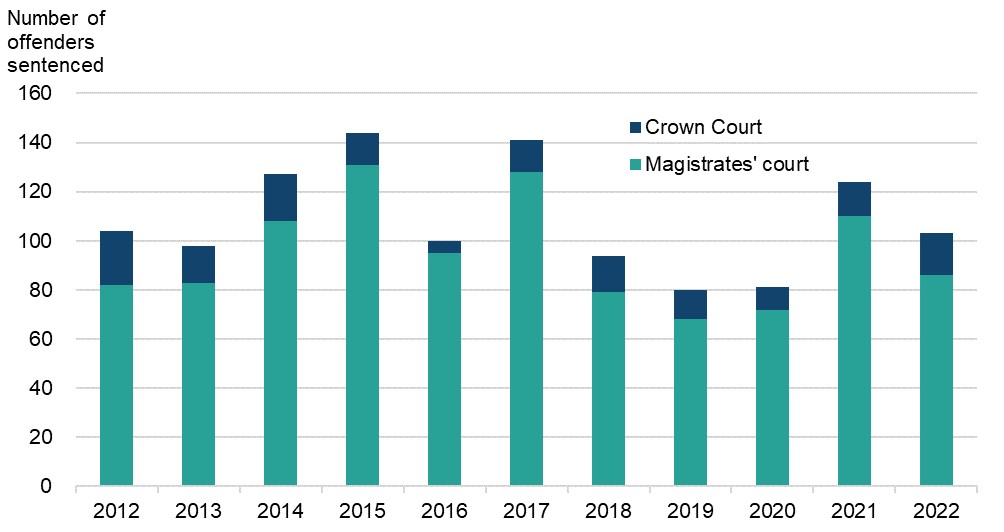
Source: Court Proceedings Database from the Ministry of Justice
Sentence outcomes
In the period following the Harassment and stalking guideline coming into force, the proportion of offenders receiving a CO increased by 24 percentage points (Table 15) compared with the pre guideline period. The proportion of offenders receiving an SSO fell by 18 percentage points, and the proportion of absolute or conditional discharges also fell by 5 percentage points.
Table 15: Proportion of adult offenders sentenced for racially or religiously aggravated harassment or stalking, by sentence outcome, pre and post guideline
Some shorthand may be used in this table: z = not applicable, k2 = less than 0.5 percentage point difference.
| Sentence outcome | Pre guideline | Post guideline | Percentage point (ppt) difference |
| Absolute or conditional discharge | 8% | 3% | -5 ppts |
| Fine | 13% | 15% | 1 ppt |
| Community order | 35% | 59% | 24 ppts |
| Suspended sentence order | 31% | 13% | -18 ppts |
| Immediate custody | 10% | 11% | [k2] |
| Other/unknown | 2% | 0% | -2 ppt |
| Total | 100% | 100% | [z] |
Source: Court Proceedings Database from the Ministry of Justice
Pre guideline period covers 1 July 2017 to 30 June 2018 (N=126), post guideline period covers 1 October 2018 to 30 September 2019 (N=75). Percentage totals and percentage point differences may not appear to sum correctly due to rounding.
However, when examining the sentence outcomes across 2012 to 2022, the large increase in proportion of COs imposed is not maintained after 2019 (Figure 24). The trend in the proportion of COs is broadly mirrored by the decline and then increase in the proportion of offenders sentenced to immediate custody. In Figure 24, the decrease observed pre to post guideline in the proportion of SSOs imposed also stops after 2019; instead, from 2020 there has been a small but steady increase.
Figure 24: Proportion of adult offenders sentenced for racially or religiously aggravated harassment or stalking, by sentence outcome, 2012 to 2022
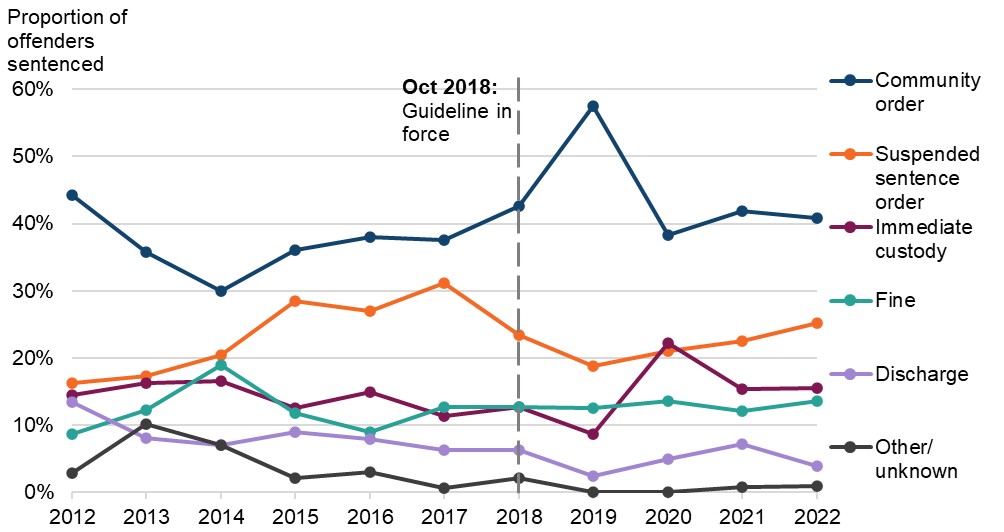
Source: Court Proceedings Database from the Ministry of Justice
It is possible the changes in sentencing seen in 2020 (the sharp increase in immediate custodial sentences and decrease in COs) may be due to the impact of the coronavirus pandemic (COVID-19). For example, there may have been a prioritisation of the most serious cases, which could have led to the spike in immediate custodial sentences. The proportion of sentence outcomes in 2021 and 2022 then return to proportions that more closely resemble those seen immediately post guideline. For previous offences in this report, a quarterly view of the data was examined to ascertain whether the Imposition guideline and letter may have had an impact in driving these changes, but due to the low volume of offenders sentenced for these offenders this was not possible to draw out.
Sentence lengths
For racially or religiously aggravated harassment and stalking, volumes of offenders sentenced to immediate custody are very low (fewer than 20 offenders most years). This has meant that the ACSLs may be skewed by extreme values and as a result these figures have not been presented. However, overall, the ACSLs for these offences appear to have remained broadly stable since before the introduction of the guideline, which suggests the guideline has not impacted sentence lengths for these offences.
3.5.4 Transcript analysis
An analysis of transcripts was conducted to review whether the racial or religious aggravation was applied as directed in the guideline. The transcript analysis was based on 13 cases seen before the Crown Court across 2019 and 2020. The majority of cases for these offences are seen at magistrates’ courts, so it is likely that the offending covered in the transcripts represents the more serious end of offending. The low number of transcripts also mean that any findings are purely indicative, and it was not possible to determine any patterns.
The guideline states “The sentencer should state in open court that the offence was aggravated by reason of race or religion, and should also state what the sentence would have been without that element of aggravation.” In 12 of the transcripts analysed, sentencers did state they were aggravating for racial or religious elements. In the remaining transcript the sentencer did refer to the offence of “Racially aggravated harassment” although no mention was made other than this. A majority of sentencers stated the sentence before the religious or racial aggravation was applied, but there were several transcripts where this had not been stated (four out of 13).
Furthermore, the transcripts were examined to review whether sentencers were applying the racial or religious uplift at the correct step. In seven of the nine transcripts which were detailed enough to ascertain the order of the steps taken, it appears the application of the uplift was applied correctly. In the other two transcripts, in one case the sentencer had not appeared to apply an uplift, stating that the racial element was the essence of the offence, and it had not been pragmatic to separate out the basic sentence from the uplift. In the other of the two, the guilty plea had been applied before the racial uplift had been applied.
Several transcripts were not detailed enough to accurately ascertain the order of the steps taken. While this does not mean the aggravation of race or religion was not factored into sentencing, the purpose of stating the uplift of the racial or religious factors separately was to ensure transparency in sentencing. Therefore, while there is no evidence the sentences did not account for the uplift, the instructions in the guideline to articulate the sentence with and without the racial and/or religious uplift was not followed and is an issue of transparency of sentencing in these cases.
It should be noted, however, that the requirement to state that the sentence was aggravated was also included the previous MCSG iteration of the guideline, so it is not a new requirement of sentencers.
On 1 April 2022, the racial and religious uplift in the guideline was separated into its own step (step 3), to give greater clarity and transparency to the uplift process (see Annex B). The racial and religious aggravation information in the guideline itself did not change (it was previously included under step 2) but has just been separated out under a new heading of step 3. It is therefore possible, that these changes could have improved sentencers’ adherence to the steps required when applying a racial and religious uplift.
One Court of Appeal transcript from 2022 was examined to check for any issues in guideline interpretation, but no issues were indicated on the basis of this transcript.
3.6 Racially or religiously aggravated harassment (putting people in fear of violence)/stalking (involving fear of violence or serious alarm or distress)
3.6.1 Summary of findings
- There was an increase in COs and a decrease in SSOs immediately post guideline. The lower proportion of SSOs appeared to be broadly maintained over time; however, there were continued fluctuations in the proportion of COs across 2019 to 2022.
- There has been an overall increase in ACSLs since 2012. However, due to very low volumes, it is not possible to determine whether changes to sentence outcomes or fluctuations in ACSLs were due to the guideline as the low volumes meant it was difficult to identify meaningful trends in the data.
- Analysis of the small sample of transcripts suggested there is a mixed picture in terms of how sentencers were applying racial and religious aggravation as part of this guideline.
3.6.2 Background
Racially or religiously aggravated harassment (putting people in fear of violence) and stalking (involving fear of violence or serious alarm or distress) were enacted as offences contrary to section 32(1)(b) under the Crime and Disorder Act 1998. These offences had a statutory maximum sentence of 7 years’ custody until 2 April 2017, and from 3 April 2017 this increased to 14 years’ custody. These offences will be referred to as racially or religiously aggravated harassment or stalking (fear of violence) hereafter.
Prior to the Harassment and stalking (fear of violence) guideline coming into force on 1 October 2018, there was a MCSG for racially or religiously aggravated harassment (fear of violence) which had been in force from 4 August 2008. However, this was only applicable for cases sentenced at the magistrates’ courts. There was no MCSG for racially or religiously aggravated stalking (fear of violence) previously.
In the intimidatory offences resource assessment, it was stated that for racially or religiously aggravated harassment or stalking (fear of violence) there may be some increase in sentences, as the consultation showed that some sentencers may categorise these racially or religiously aggravated harassment or stalking (fear of violence) cases at a higher level of harm than the non-aggravated cases. This means the cases may have been categorised at a higher level of harm before the uplift for the racial or religious aggravation is applied. However, as stated in the racially or religiously aggravated harassment/stalking section, these changes were expected to lead to a small impact overall due to these being low volume offences, increasing the requirement of prison places by fewer than 10 per year (this figure again covers racially or religiously aggravated forms of harassment, stalking, harassment (fear of violence) and stalking (fear of violence).
Any additional impact on the average custodial sentence lengths for these offences was expected to be due to the legislative change increasing the statutory maximum sentence from 7 years’ custody to 14 years’ custody, and not as a result of the guideline.
3.6.3 Trend analysis
Sentence volumes
Racially or religiously aggravated harassment and stalking (fear of violence) are low volume offences (see Annex A for information on limitations, particularly in relation to potential larger fluctuations in the data). In 2022, around 60 offenders were sentenced for these offences. The proportion of cases sentenced at the Crown Court increased slightly from 2019 onwards.
Figure 25: Number of adult offenders sentenced for racially or religiously aggravated harassment or stalking (fear of violence), 2012 to 2022
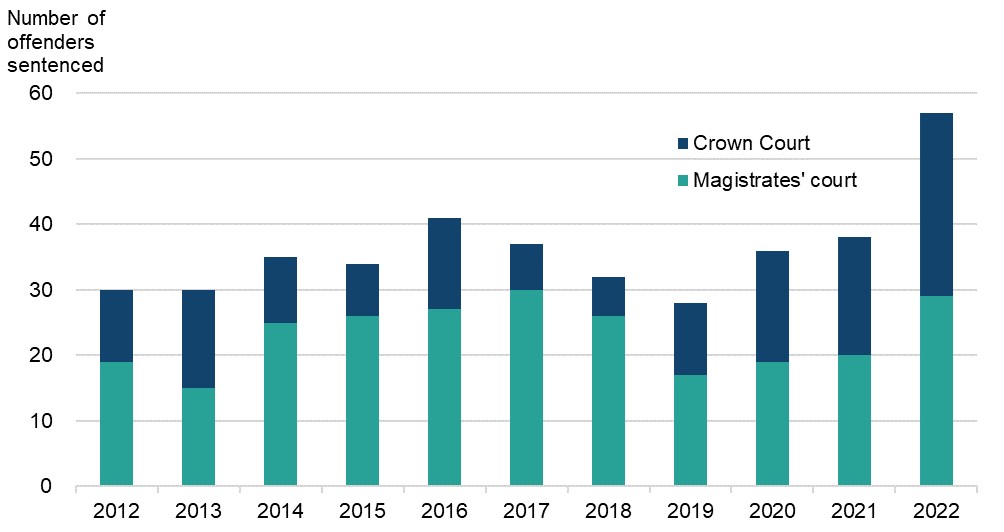
Source: Court Proceedings Database from the Ministry of Justice
Sentence outcomes
Table 16 indicates there was an increase in COs (11 percentage points) and a decrease in SSOs (16 percentage points) post guideline. As the number of offenders sentenced pre and post guideline are very low, this finding should be viewed as indicative only; however this pattern is consistent with other offences examined in this report.
Table 16: Proportion of adult offenders sentenced for racially or religiously aggravated harassment or stalking (fear of violence), by sentence outcome, pre and post guideline
Some shorthand may be used in this table: z = not applicable.
| Sentence outcome | Pre guideline | Post guideline | Percentage point (ppt) difference |
| Absolute or conditional discharge | 3% | 0% | -3 ppts |
| Fine | 0% | 3% | 3 ppts |
| Community order | 21% | 32% | 11 ppts |
| Suspended sentence order | 48% | 32% | -16 ppts |
| Immediate custody | 27% | 29% | 2 ppts |
| Other/unknown | 0% | 3% | 3 ppts |
| Total | 100% | 100% | [z] |
Source: Court Proceedings Database from the Ministry of Justice
Pre guideline period covers 1 July 2017 to 30 June 2018 (N=33), post guideline period covers 1 October 2018 to 30 September 2019 (N=31). Percentage totals and percentage point differences may not appear to sum correctly due to rounding.
Despite the low volumes, the data in Figure 26 indicate the decrease in the proportion of SSOs since 2018, when the guideline came into force, is maintained over time. The picture with COs is less clear as there are large fluctuations across the time period presented, although overall there does appear to be a decrease proportion of COs received since 2018.
Figure 26: Proportion of adult offenders sentenced for racially or religiously aggravated harassment or stalking (involving fear of violence), by sentence outcome, by year, 2012 to 2022
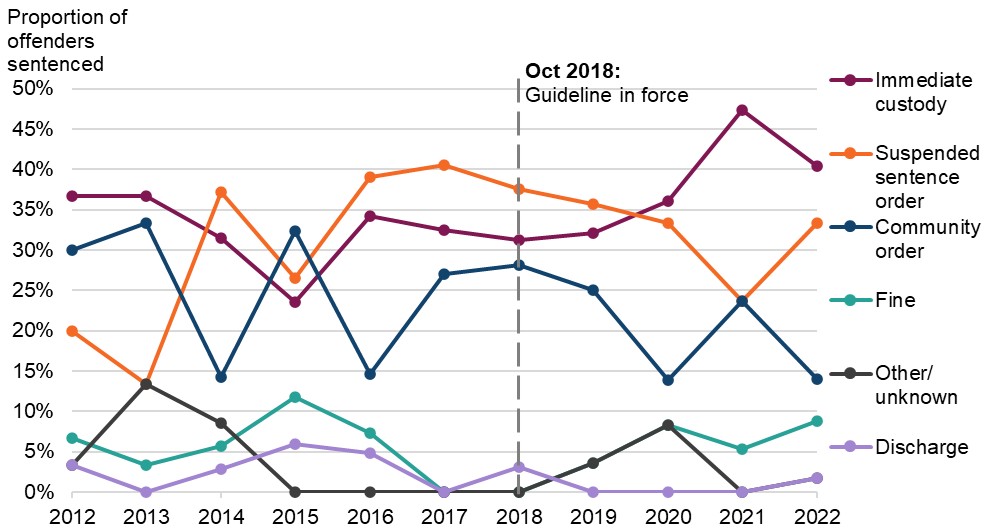
Source: Court Proceedings Database from the Ministry of Justice
The low volumes mean it is not meaningful to break the data down further, by quarters, to review whether the Imposition guideline or letter may have played a role in affecting sentence outcomes, or if other factors are driving these changes. It is therefore not possible to say, given the timing of the changes, whether these are due primarily to the Harassment and stalking (fear of violence) guideline, the Imposition guideline, or any other factors.
Sentence lengths
The resource impact stated that there may be a small increase in sentence lengths where racially and religiously aggravated harassment and stalking (fear of violence) cases may be categorised at a higher level of harm in step one of the guideline (than non-aggravated offences). Additionally, any further changes to average custodial sentence lengths (ACSL) would be expected to be due to the legislation rather than the guideline.
Volumes of offenders sentenced to immediate custody for racially or religiously aggravated harassment or stalking (fear of violence) are also very low (fewer than 20 offenders each year). Figures of ACSLs have therefore not been presented, because of the potential for extreme values to skew these figures. While this means no firm conclusions can be drawn, across 2012 to 2022 there does appear to be an overall increase in ACSLs for these offences. It is not possible to ascertain whether the increase is tied to the statutory maximum sentence change, the guideline coming into force, or whether it is a pre-existing ongoing trend.
3.6.4 Transcript analysis
As with the racially or religiously aggravated harassment or stalking offences, a small sample of transcripts were selected to review whether the racial or religious aggravation was applied as instructed by the guideline. The transcript analysis was based on 20 transcripts of cases heard before the Crown Court across 2019 and 2020.
Around half of cases for this offence are seen at the magistrates’ courts, so it is likely that the offending described in the transcripts is not typical of the usual offending and would represent the more serious end of offending. The relatively low number of transcripts analysed means that, again, any findings are indicative.
The application of the racial and religious aggravation was analysed in several ways. Analysis of how the racial and religious aggravation was applied was examined in several ways. Firstly, transcripts were reviewed to see if the sentencer had explicitly stated whether the offence was racially or religiously aggravated, as specified by the guideline. It was found in the majority of cases (14 of 20) sentencers did. However, of these 14 sentencers, two just mentioned by name the offence ‘racially aggravated’ but did not provide any further details, and one sentencer provided information on the racial aggravation after being prompted by the prosecutor.
Secondly, it was examined whether sentencers stated what the sentence would have been without the element of aggravation, as specified by the guideline. Only just over half of sentencers (12 out of 20) provided the sentence before and after the racial or religious aggravation had been applied. In one further case, the transcript was unclear. In the remaining seven cases, sentencers did not state the sentence before and after any aggravation for the racial or religious factors was applied, and so it is not known whether they were factored into sentencing, or what weight was given to them. Of these seven, one sentencer explicitly stated that given the sentence they were planning to impose they did not propose to say what the sentence would have been with or without the uplift, and suggested the offence had only been aggravated by a small amount.
The requirement to state what the sentence would have been without the element of aggravation was included in the previous MCSG for harassment/stalking (fear of violence), and so is not a new requirement for sentencers. On the basis of the information contained within the transcripts, it appears that sentencers may have aggravated for the racial or religious element, but not indicated this was a separate step. These requirements of sentencers to state that the offence was aggravated on the basis of race or religion and what the sentence before and after racial or religious aggravation was included for the purposes of transparency in sentencing. Therefore, while the guideline may have been followed to arrive at an appropriate sentence, by not stating the impact of the racial or religious aggravation on the sentence, there is a potential issue around transparency in sentencing for these cases.
In terms of how the racial or religious aggravation was applied, in 10 of the 20 cases the uplift appears to have been applied at the correct step (after applying aggravation and mitigation at step 2). In a further six cases it was not clear whether the uplift was included in the final sentence, and in one additional case it appears a guilty plea reduction was applied before the uplift. In two further cases, the sentence before and after the uplift wasn’t stated. In the final case, the sentencer potentially double counted the racial element of the offending; they firstly accounted for the racial element when considering culpability, by taking into account the culpability B factor ‘Offence motivated by, or demonstrating, hostility based on any of the following characteristics or presumed characteristics of the victim: age, sex, disability, sexual orientation or transgender identity’, although the guideline specifically does not include race in this factor. The sentencer then also went onto apply the uplift to the sentence to account for the racial aggravation.
Overall, it appears that the transcript sample has indicated that a sizeable minority of sentencers are not always stating that the offence was racially or religiously aggravated as required by the guideline, and are not stating the sentence before and after the racial or religious aggravation has been applied which is also required by the guideline. Furthermore, in two cases it is likely that the sentence arrived at would have been different if the guideline had been followed, as there was potential double counting in one case and the racial or religious uplift was applied after the guilty plea in the other.
As noted in Annex B the racial and religious uplift was separated into its own step (step 3) in April 2022, to give greater clarity and transparency to the uplift process. The guidance relating to how to apply it however did not change. It is possible that the sentencers’ behaviour has changed in regard to adherence to the racial and religious uplift steps following this change, but we are unable to determine whether this is the case as the transcripts used for analysis in this report cover an earlier time period.
3.7 Threats to kill
3.7.1 Summary of findings
- There was an increase in COs and decrease in SSOs immediately after the introduction of the Threats to kill guideline. However, these changes appear to revert again across 2020 and 2021.
- There does not appear to be any clear changes in sentence outcomes resulting from the Threats to kill guideline coming into force, as anticipated in the intimidatory offences resource assessment.
- The ACSL did appear to increase as a result of the introduction of the guideline, which had not been anticipated. Sentences of 2 to 4 years’ custody in particular increased, and sentences of up to 2 years decreased. Analysis reviewing the starting points of the Threats to kill guideline and a sample of transcripts suggests this may be a result of either more cases falling into the highest, ‘A1’ category, or the starting points received for ‘A1’ cases being higher than under the Magistrates’ Court Sentencing Guideline.
3.7.2 Background
The offence of threats to kill (Offences Against the Person Act 1861, s.16) is a triable either way offence, with a statutory maximum sentence of 10 years’ custody. Prior to the introduction of the Threats to kill guideline on 1 October 2018, there was a Magistrates’ Court Sentencing Guideline for this offence from 4 August 2008 which was applicable in magistrates’ courts only.
In the intimidatory offences resource assessment, it was stated that sentencing ranges were set with current sentencing practice in mind for the offence of threats to kill and as a result, no change in sentencing was expected.
3.7.3 Trend analysis
Sentence volumes
The volume of offenders sentenced each year between 2012 and 2022 for the offence of threats to kill has remained relatively stable, fluctuating between approximately 400 to 600 offenders sentenced each year. In 2022, around 530 offenders were sentenced for this offence. Approximately 65 to 75 per cent of offenders were sentenced in the Crown Court each year. There was an increase from 2019 to 2021 in the proportion of offenders sentenced to the Crown Court (from 66 per cent in 2018, to 75 per cent in 2019), but this decreased again in 2022 (66 per cent), so it is unclear whether it is tied to the guideline coming into force.
Figure 27: Number of adult offenders sentenced for threats to kill, by court type, 2012 to 2022
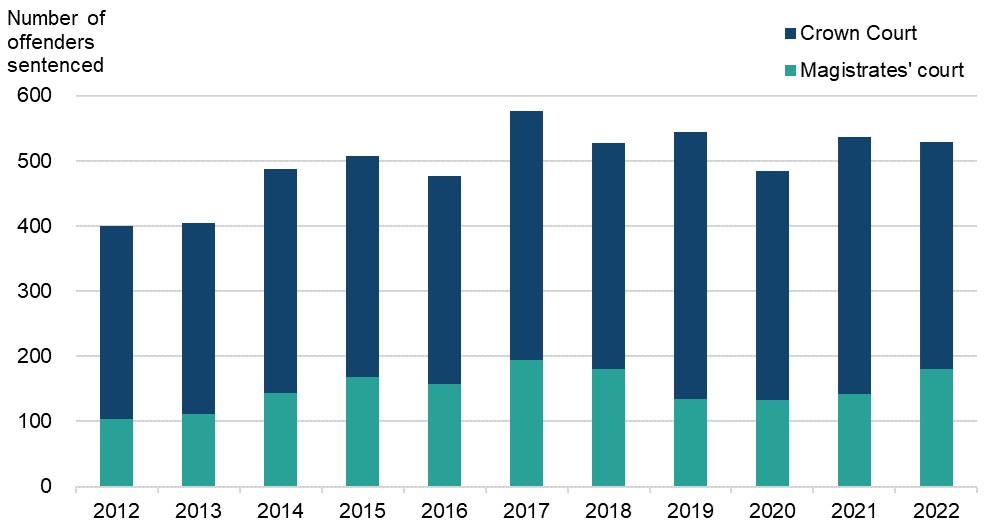
Source: Court Proceedings Database from the Ministry of Justice Sentence outcomes
Analysis from the CPD comparing the proportions of sentence outcomes pre and post guideline showed that the proportion of offenders who received a CO increased by 5 percentage points in the period post guideline. There was also a 3 percentage point decrease in the proportion of offenders receiving an SSO. The increase in COs and decrease in SSOs continues the pattern seen post guideline implementation with the other offences (with the exception of stalking (fear of violence)) discussed so far, although the pattern seen for this offence reflects a smaller change.
Table 17: Proportion of adult offenders sentenced for threats to kill, by sentence outcomes, pre and post guideline
Some shorthand may be used in this table: z = not applicable, k1 = less than 0.5 per cent, k3 = less than -0.5 percentage point difference.
| Sentence outcome | Pre guideline | Post guideline | Percentage point (ppt) difference |
| Absolute or conditional discharge | 1% | 1% | [k3] |
| Fine | 1% | [k1] | [k3] |
| Community order | 13% | 18% | 5 ppts |
| Suspended sentence order | 29% | 26% | -3 ppts |
| Immediate custody | 53% | 52% | -1 ppt |
| Other/unknown | 3% | 2% | [k3] |
| Total | 100% | 100% | [z] |
Source: Court Proceedings Database from the Ministry of Justice
Pre guideline period covers 1 July 2017 to 30 June 2018 (N=570), post guideline period covers 1 October 2018 to 30 September 2019 (N=521). Percentage totals and percentage point differences may not appear to sum correctly due to rounding.
As seen in Figure 28, there was a clear decrease in the proportion of SSOs received in 2018 and 2019, although this increased again in 2020 to 2021 returning to levels seen pre guideline. In 2022 the proportion of SSOs then decreases again in line with the 2018 proportions. The increase in the proportion of offenders sentenced to COs broadly persists through to 2022, with some small fluctuations year on year. In 2022, 19 per cent of offenders were sentenced to COs for this offence, the highest proportion since 2013.
Figure 28: Proportion of adult offenders sentenced for threats to kill, by outcome, by year, 2012 to 2022
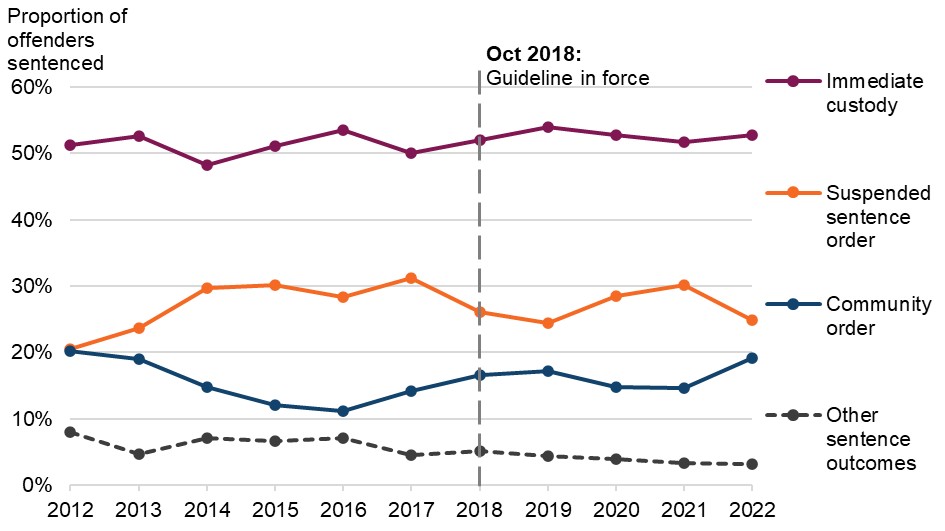
Source: Court Proceedings Database from the Ministry of Justice
To explore what may be causing the pattern seen in the data around the introduction of the guideline, sentence outcomes have been presented on a quarterly basis (Figure 29). The data in Figure 29 demonstrate that there is an overall trend showing a decrease in SSOs across 2018, including the period prior to the Threats to kill guideline coming into force, and that this decline continues through 2019. Similarly, the increase in the proportion of COs appears to begin in 2018 (again prior to the guideline coming into force) and is sustained throughout 2019. Therefore, it does not appear from the data that the Threats to kill guideline had any impact on changes to sentence outcomes, in line with the impact set out in the resource assessment.
Figure 29: Proportion of adult offenders sentenced for threats to kill, by sentence outcome, by quarter, July 2016 to December 2019

Source: Court Proceedings Database from the Ministry of Justice
Q1 (Quarter 1) covers January to March, Q2 covers April to June, Q3 covers July to September, and Q4 covers October to December.
Sentence lengths
The resource assessment also indicated that no change was expected to the average custodial sentence length (ACSL). However, Figure 30 indicates that in 2018 there was a slight increase in ACSL, which then increased further in 2019, after which it modestly declined through to 2022. In 2017, before the Threats to kill guideline came into force, the ACSL was 18 months. This increased slightly to 19 months in 2018 and then finally increased to 24 months in 2019 where the ACSL has roughly stayed at across 2020 to 2022, fluctuating between 22 and 23 months. This pattern of increase suggests the guideline may have contributed to an overall increase in the ACSL for this offence by around 4 to 6 months.
Figure 30: Average custodial sentence length (ACSL) in months for threats to kill, by year, 2012 to 2022
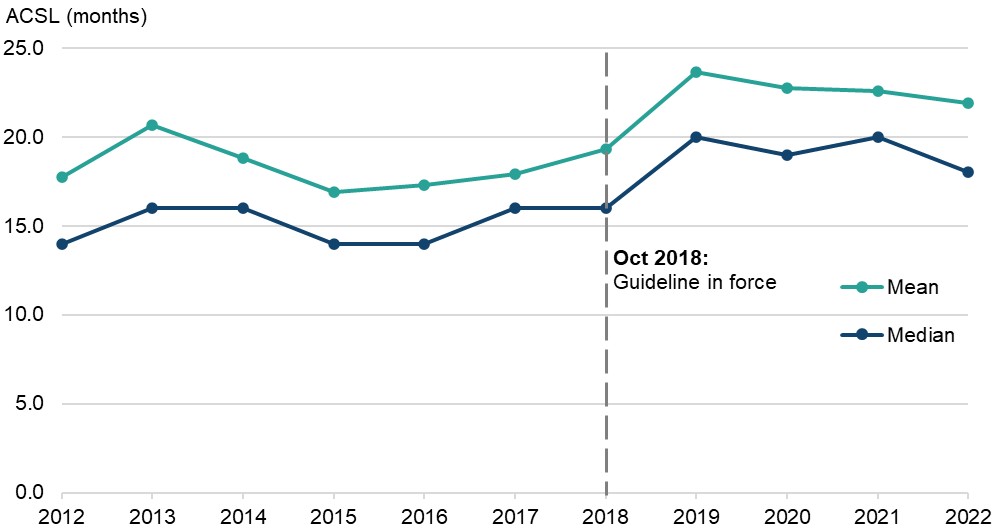
Source: Court Proceedings Database from the Ministry of Justice
Indeterminate sentences were excluded from analysis.
Figure 31 provides a detailed breakdown of sentence lengths by year, to help identify which sentence length bands may have been affected by the guideline, and which led to the increase in ACSLs seen from 2018 onwards.
Figure 31: Proportion of offenders sentenced to immediate custody for threats to kill, by sentence length, by year, 2012 to 2022
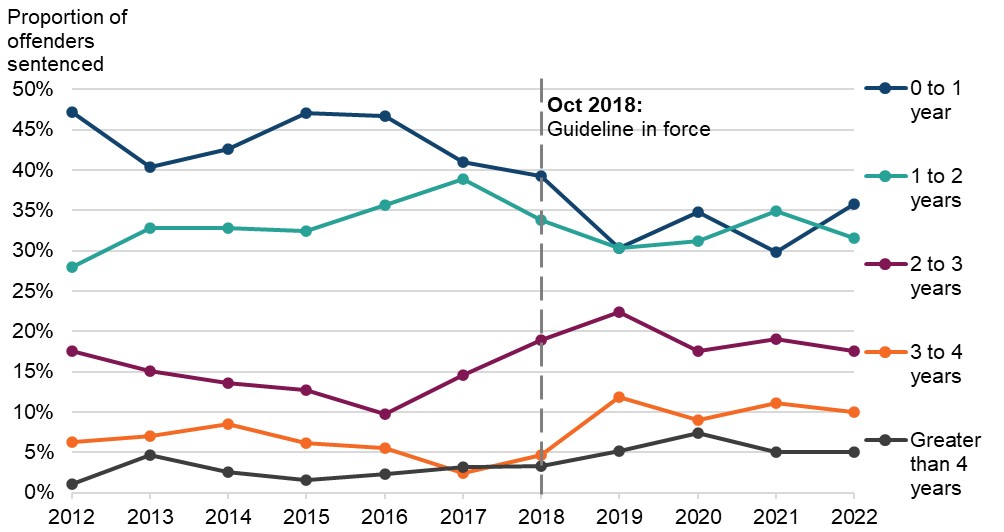
Source: Court Proceedings Database from the Ministry of Justice
Indeterminate sentences were excluded from analysis.
It can be seen that between 2017 and 2019, sentences of up to 2 years’ custody decreased. The proportion of offenders receiving an immediate custodial sentence of 0 to 1 years reduced by 11 percentage points, and those receiving a sentence of 1 to 2 years reduced by 9 percentage points. The proportions then remained relatively stable from 2019 to 2022. Sentences of 2 to 3 years appear to have increased slightly post guideline (by approximately 5 percentage points), and the same is true for sentences of 3 to 4 years (approximately 5 percentage points). Sentences of 4 years or higher also show some small but consistent increases of around 2 to 3 percentage points post guideline.
Overall, the guideline may in some way be decreasing immediate custodial sentences of 2 years or less and increasing in particular sentences of around 2 to 4 years’ custody.
3.7.4 Guideline review
To examine what within the guideline may be driving the changes in sentence lengths, the MCSG for threats to kill and the Threats to kill guideline were compared. The MCSG was only applicable for cases seen in the magistrates’ courts, so only a partial comparison of what might have led to changes in sentencing can be assessed. The sentencing table includes starting points for a medium level CO or 12 weeks’ custody and then more serious cases were to be sent to the Crown Court.
Figure 32: The sentencing table from the MCSG for threats to kill

Source: Magistrates’ Court Sentencing Guidelines from the National Archive
Given that sentences of less than 2 years (post guilty plea reduction) have decreased since the new guideline came into force, it may suggest that post guideline, cases are receiving higher starting points, which may have led to the increase in sentences of 2 to 4 years in particular.
It is important to note that the sentencing table includes sentences before any guilty plea reduction has been applied, so when reviewing the starting points and category ranges within the sentencing table to work out how, on balance, sentences of 2 years or higher may be arrived at, allowance for any guilty plea reduction must also be considered.
Figure 33: The sentencing table from the Threats to kill guideline

Source: Threats to kill guideline from the Sentencing Council website
In the Sentencing Council Threats to kill guideline, six of the nine starting points are at 1 year’s custody or lower. Of these six starting points, only three of the boxes include a range with a custodial sentence over two years. Therefore, while possible, it might be unlikely that with these starting points an offender would end up with a final sentence of greater than 2 years, especially if a guilty plea reduction of more than 25 per cent was applied.
This suggests, therefore, that cases are possibly falling more into the three higher starting point boxes: ‘A1’ with a starting point of 4 years’ custody and ‘B1’ or ‘A2’ with a starting point of 2 years’ custody. This is further explored in the transcript analysis section below.
3.7.5 Transcript analysis
Analysis of 18 Crown Court transcripts from 2020 has been conducted to examine whether the guideline has been used as expected, and to examine the issue of whether any reasons can be found for the ACSL increase. In 2020, approximately 73 per cent of cases were seen at the Crown Court (see Figure 27 for court type split for this offence). A sample that broadly represents the range of cases seen at the Crown Court across sentencing outcomes and sentence lengths was selected.
All but one offender pled guilty, and of those that did, nearly two-thirds (11 cases) received a 33 per cent reduction to their final sentence. A further four cases received a 25 per cent reduction, and in the remaining two cases the reduction was not known.
Of the 18 cases, a third were placed into the ‘A1’ category by the sentencing judge. There were no ‘B1’ cases; all cases falling into B culpability received a harm categorisation 2 or 3. All cases where the final sentence outcome was 2 years or higher had received an ‘A1’ classification, with the exception of one case where the culpability and harm levels were not stated.
It is possible that the increase in proportion of cases receiving 2 to 4 years seen in the CPD data is due to the volume of cases falling into ‘A1’. Given the vast majority of transcripts analysed for this offence indicated offenders had pled guilty, to receive a sentence of 2 to 4 years post guilty plea reduction, the starting point may have to be at least 3 to 4 years. For example, if a sentencer chose a starting point of 3 years and applied a guilty plea reduction of 33 per cent this would be 2 years as a final sentence. This would align with a possible explanation of an increase in ‘A1’ cases resulting in higher sentences in the range of 2 to 4 years, as the starting point for ‘A1’ cases is 4 years’ custody.
It is also possible that sentences of more than 2 years could be achieved by an offender’s case being classified as ‘B1’ or ‘A2’ (each of which have a starting point of 2 years, with a category range going up to 4 years), the starting point being aggravated to a higher point in the range and no guilty plea reduction being applied. However, the transcripts indicate this may not be the cause of increased sentences as no offenders received a ‘B1’ categorisation in the sample and the majority (all but one) of the offenders did plead guilty. Of the three offenders who received an ‘A2’ categorisation, the final sentences received were between 10 months and 1 year 2 months, providing some indicative support that it may be unlikely the ‘B1/A2’ categories could be leading to sentences over 2 years’ custody.
It is therefore possible that more offenders are falling into ‘A1’ than the highest level of seriousness under the MCSG, and this may be the reason for the increase in overall sentence lengths. Alternatively, it is possible that there was a similar proportion of cases falling into the highest MCSG category pre guideline compared with the ‘A1’ category post guideline, but sentences are increased due to the higher starting point in the Threats to kill guideline for cases falling into ‘A1’. However, as the proportion of offenders who fell into the highest level of seriousness under the MCSG is not known, it is not possible to determine which scenario would be supported by the data.
In terms of implementation, there did not appear to be any issues apparent from the sample of transcripts. One Court of Appeal transcript for a case from 2022 was also reviewed, but the appeal did not indicate any issues in interpretation or use of the Threats to kill guideline.
3.8 Disclosing private sexual photographs and films with intent to cause distress
3.8.1 Summary of findings
- Overall, for the offence of disclosing private sexual photographs and films with intent to cause distress, there was a slight decrease in the proportion of SSOs and an increase in proportions of COs briefly after the guideline came into force, but these changes were then reversed. It is unclear whether the changes seen were driven by the introduction of the guideline, the Imposition guideline or another factor, as the data fluctuate over these periods.
- The ACSL for this offence has increased steadily over time since its introduction, eventually plateauing from 2020 onwards. There were some changes seen in median ACSL across 2018 and 2019, but it is unclear whether these are due to the guideline or part of a pre-existing trend.
- Transcripts from cases seen at the Crown Court did not highlight any issues in sentencing, and showed that there was a split of harm cases seen, and that the factors ‘Conduct intended to maximise distress and/or humiliation’ and ‘Images circulated widely/publicly’ in particular were discussed for cases falling into culpability A.
3.8.2 Background
The offence of disclosing private sexual photographs and films with intent to cause distress (contrary to s.33 of the Criminal Justice and Courts Act 2015) was a triable either way offence that was repealed on 31 January 2024. This offence had originally come into force on 13 April 2015 and had a statutory maximum sentence of 2 years’ custody. For brevity, the offence will be referred to as disclosing private sexual images. Prior to the introduction of the Disclosing private sexual images guideline in 2018, there was no previous guideline. The evaluation of this guideline is included for completeness.
The guideline for disclosing private sexual images was intended to maintain existing sentencing practice, therefore the resource assessment stated there was no expected impact on prison and probation resources.
3.8.3 Trend analysis
Sentence volumes
Around 260 offenders were sentenced for disclosing private sexual images in 2022. Volumes for this offence previously peaked in 2016 and 2017 in the years immediately following the introduction of the offence, when volumes were around 230 to 280 respectively. The proportion of cases sentenced at the Crown Court in 2016 and 2017 (pre guideline) were around 16 to 22 per cent. In 2018 this increased to 30 per cent, with further increases up to 2021 where 36 per cent of offenders were sentenced at the Crown Court. This proportion then decreased slightly in 2022 to around 29 per cent of offenders.
Figure 34: Number of adult offenders sentenced for disclosing private sexual images, by court type, 2015 to 2022
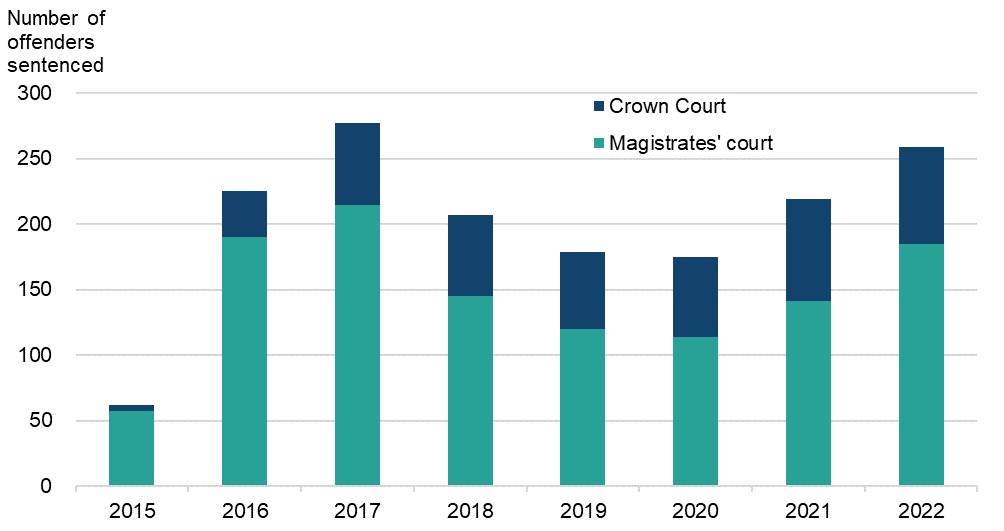
Source: Court Proceedings Database from the Ministry of Justice
Sentence outcomes
Data from the CPD were examined to compare the pre and post guideline sentence outcomes to assess whether there has been any change in sentencing as a result of the guideline. As shown in Table 18, the proportion of offenders sentenced for disclosing private sexual images who received a CO increased by 8 percentage points from the pre guideline period to the post guideline period. There was also a 12 percentage point decrease in the proportion of offenders receiving an SSO. This continues to be in line with the pattern for the majority of the intimidatory offences.
Table 18: Proportion of adult offenders sentenced for disclosing private sexual images, by sentence outcome, pre and post guideline
Some shorthand may be used in this table: z = not applicable, k2 = less than 0.5 percentage point difference.
| Sentence outcome | Pre guideline | Post guideline | Percentage point (ppt) difference |
| Absolute or conditional discharge | 2% | 4% | 2 ppts |
| Fine | 2% | 3% | [k2] |
| Community order | 32% | 39% | 8 ppts |
| Suspended sentence order | 44% | 32% | -12 ppts |
| Immediate custody | 20% | 22% | 2 ppts |
| Other/unknown | 0% | 0% | 0 ppts |
| Total | 100% | 100% | [z] |
Source: Court Proceedings Database from the Ministry of Justice
Pre guideline period covers 1 July 2017 to 30 June 2018 (N=243), post guideline period covers 1 October 2018 to 30 September 2019 (N=170). Percentage totals and percentage point differences may not appear to sum correctly due to rounding.
As seen in Figure 35, post guideline, the proportions of SSOs and COs fluctuate across the period from 2015 to 2022; the proportion of offenders receiving an SSO for this offence decreases in 2018 and 2019, but then increases in 2020 and 2021 to the highest levels since the guideline came into force, before dropping again in 2022. The reverse picture is seen with proportions of COs.
It is possible that the changes seen in sentencing across 2020 to 2021 (Figure 35) are a result of the impact of COVID-19, which may have led to a change in case mix seen before the courts. In 2022, the proportion of COs and SSOs returning to levels seen in 2019 support this.
Figure 35: Proportion of adult offenders sentenced for disclosing private sexual images, by outcome, 2015 to 2022
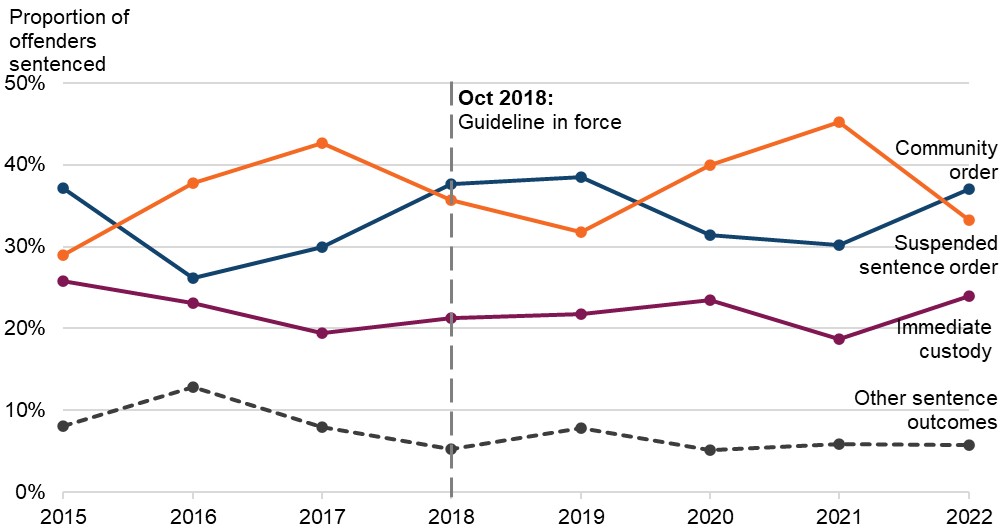
Source: Court Proceedings Database from the Ministry of Justice
The overall change in SSOs and COs seen in Figure 35 follows the pattern seen for other offences: a potential impact related to the Imposition guideline or letter. This is examined further in Figure 36. In Figure 36, the data is split by quarter, and due to the low numbers of offenders sentenced each quarter (between approximately 40 to 70 on any given year) there is much greater fluctuation in proportion of outcomes. However, it does show that the most marked increase in COs is seen at Q3 2018 rather than Q2 2018, when the impact of the Imposition guideline letter is usually seen. In addition, the decrease in SSOs could be argued to be decreasing from Q1 2018, prior to the letter being published. Therefore, it is possible these changes are driven by a different factor, rather than imposition or the guideline.
Figure 36: Proportion of adult offenders sentenced for disclosing private sexual images, by sentence outcome, by quarter, July 2016 to December 2019

Source: Court Proceedings Database from the Ministry of Justice
Quarter 1 (Q1) covers January to March, Q2 covers April to June, Q3 covers July to September, and Q4 covers October to December.
Sentence lengths
Figure 37 shows the ACSL for disclosing private sexual images has been gradually increasing since the offence came into force in 2015 until it stabilised at around 7 months from 2020 onwards. While the mean ACSL does not show a clear change around 2018 and 2019, the median ACSL does show an increase from 2018 to 2019, before then remaining stable from 2019 onwards. As there was a pre-existing trend of an increase in ACSL (mean and median) prior to the guideline coming into force, it is not possible to determine whether the continued increase relates to the guideline, or another factor.
Figure 37: Average custodial sentence length (ACSL) in months for disclosing private sexual images, 2015 to 2022
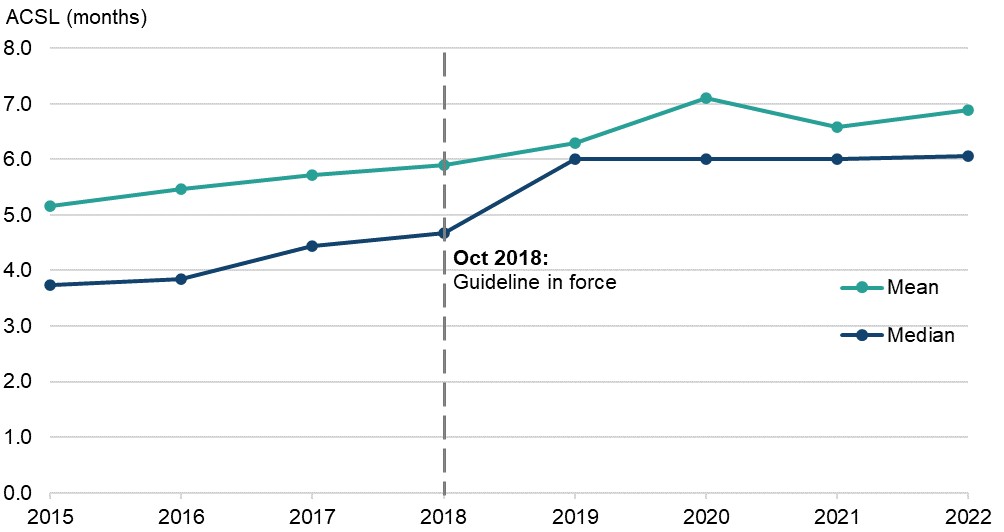
Source: Court Proceedings Database from the Ministry of Justice
3.8.4 Transcript analysis
The majority of disclosing private sexual images cases are seen at the magistrates’ court (65 per cent in 2020). However, transcripts of sentencing remarks from magistrates’ court cases are not available. Instead, a sample of 13 disclosing private sexual image transcripts from the Crown Court were selected, based on a spread of the types of cases heard there. This means the transcripts will likely reflect more serious offending.
The majority of cases (10 of the 13) were sentenced without any other offences alongside. In this sample, all offenders pled guilty, and the majority received a 25 per cent (five offenders) or 33 per cent (three offenders) guilty plea reduction.
Of the 13 cases, 10 fell into culpability A. This would be expected given the transcripts are Crown Court cases, and the only category of culpability and harm with a starting point above the magistrates’ sentencing powers (of sentencing up to 6 months’ custody during the time periods covered by this evaluation) is ‘A1’. One further case fell into culpability B, and two cases had no culpability stated. ‘A2’ and ‘B2’ cases start at 6 months’ custody with a category range of 12 weeks to 1 year’s custody.
Of the 10 cases which fell into culpability A, 6 received an immediate custodial sentence, 3 received an SSO and 1 received a CO (where it appears the sentencer dropped a threshold as part of the guilty plea reduction).
When examining the factors which drew the cases into the culpability A category, only six of the 10 transcripts provided details. In five transcripts the factor ‘Conduct intended to maximise distress and/or humiliation’ was discussed, and in three the factor ‘Images circulated widely/publicly’ was referred to.
There was a roughly even split of cases falling into harm 1 and harm 2. The harm 1 factors most commonly referenced were ‘Very serious distress caused to the victim’ and ‘Offence has a considerable practical impact on the victim’. Cases which fell into harm 2 had little detail provided regarding the relevant factors, so features of these cases are not clear.
Overall, the transcripts did not reveal any issues with the use of the guideline: the more severe cases were sentenced as expected and a mixture of cases fell into each of the harm categories.
3.9 Controlling or coercive behaviour in an intimate or family relationship
3.9.1 Summary of findings
- Overall, changes in sentencing practice for the offence of controlling or coercive behaviour have been occurring since the offence came into force in 2015. However, the guideline may have had a small impact on increasing immediate custodial sentences and decreasing the proportion of COs.
- The ACSL increased in 2018 and 2019 before stabilising from 2020 onwards, suggesting the guideline has played a role in this increase. Analysis of transcripts suggest the increase in sentencing lengths may be due to the volume of offenders falling into the highest, ‘A1’, category. This is not in line with the resource assessment, which anticipated no changes as a result of the guideline.
3.9.2 Background
The offence of controlling or coercive behaviour in an intimate or family relationship came into force on 29 December 2015, and is contrary to s.76 of the Serious Crime Act 2015. Prior to 2018 no guidelines were available for the sentencing of this offence, which has a statutory maximum sentence of 5 years’ custody. The guideline will be referred to as ‘Controlling or coercive behaviour’ hereafter.
The guideline for controlling or coercive behaviour was intended to maintain existing sentencing practice and the resource assessment stated there was no impact expected on prison and probation resources as a result. As this was a new offence, any increases in prison places were expected to be due to a gradual increase in the number of offenders sentenced rather than as a result of the guideline.
3.9.3 Trend analysis
Sentence volumes
Volumes for this offence have broadly increased year on year since the offence came into force in December 2015. The volume of offenders sentenced for controlling or coercive behaviour in 2022 was around 530. The offence is triable either way, and the majority of cases are sentenced in the Crown Court. Since 2019, the proportion of cases sentenced at the Crown Court has stabilised at approximately 90 per cent.
Figure 38: Number of adult offenders sentenced for controlling or coercive behaviour, by court type, 2016 to 2022
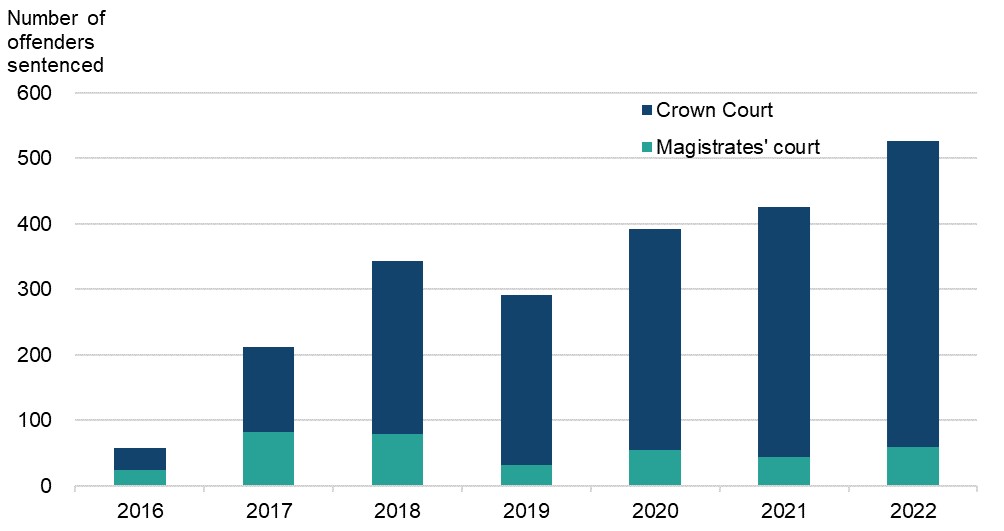
Source: Court Proceedings Database from the Ministry of Justice
The graph excludes 2015 as no offenders were sentenced for controlling or coercive behaviour in this year.
Sentence outcomes
Table 19 demonstrates that post the guideline’s introduction, the proportion of offenders who received a CO decreased by 5 percentage points, and there was a 7 percentage point increase in the proportion of offenders who received immediate custody. There was no change pre and post in the proportion of offenders receiving an SSO. This is different to the pattern seen across most other offences covered in this evaluation.
Table 19: Proportion of adult offenders sentenced for controlling or coercive behaviour, by sentence outcome, pre and post guideline
Some shorthand may be used in this table: z = not applicable, k1 = less than 0.5 per cent, k3 = less than -0.5 percentage point difference.
| Sentence outcome | Pre guideline | Post guideline | Percentage point (ppt) difference |
| Absolute or conditional discharge | 1% | 1% | [k3] |
| Fine | [k1] | 0% | [k3] |
| Community order | 15% | 10% | -5 ppts |
| Suspended sentence order | 27% | 27% | [k3] |
| Immediate custody | 56% | 63% | 7 ppts |
| Other/unknown | 1% | 0% | -1 ppts |
| Total | 100% | 100% | [z] |
Source: Court Proceedings Database from the Ministry of Justice
Pre guideline period covers 1 July 2017 to 30 June 2018 (N=314), post guideline period covers 1 October 2018 to 30 September 2019 (N=306). Percentage totals and percentage point differences may not appear to sum correctly due to rounding.
Figure 39 shows the change in sentence outcomes over time. There is an increase in immediate custodial sentences in 2018 which further increases in 2019 and then remains relatively stable from 2020 to 2022. COs show the opposite pattern, decreasing across 2018 and 2019 and then remaining broadly stable from 2020 onwards.
Figure 39: Proportion of adult offenders sentenced for controlling or coercive behaviour in an intimate or family relationship, by outcome, by year, 2016 to 2022
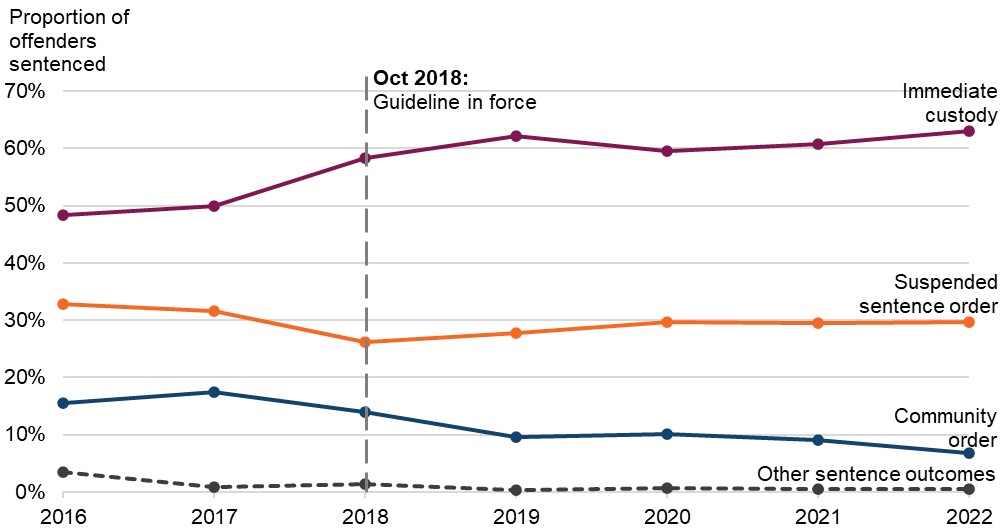
Source: Court Proceedings Database from the Ministry of Justice
The time series excludes 2015 as no offenders were sentenced for controlling or coercive behaviour in this year.
To review whether these changes may have been due to the Controlling or coercive behaviour guideline coming into force or impacted by the introduction of the Imposition guideline, the data has been split by quarter (Figure 40). Note that in Q3 and Q4 of 2016, and Q1 of 2017 the volumes of offenders were particularly low (around 20), which is likely to be the reason for the fluctuations in this time period.
Figure 40 suggests there was a decrease in SSOs following the introduction of the Imposition guideline in Q1 2017. However, considering the relatively recent introduction of this offence and the low volumes, it is not possible to say whether this was a result of the Imposition guideline or part of the offence bedding in.
Despite some fluctuations after Q4 2018 when the Controlling or coercive behaviour guideline came into force, the proportion of offenders receiving immediate custodial sentences appears to have broadly increased since the start of 2017. The proportion of COs received by offenders for this offence appear to have decreased very slightly over time and the proportion of offenders receiving SSOs remained relatively stable following initial fluctuations between Q3 2016 and Q2 2017.
The changes seen in Q4 2018, which are maintained through 2019, in the proportion of offenders receiving immediate custodial or CO sentence outcomes indicate a possible influence of the Controlling or coercive behaviour guideline; however these changes also appear to be part of a pre-existing trend in the data from 2017, so it is not possible to determine with any certainty the role of the guideline.
Figure 40: Proportion of adult offenders sentenced for controlling or coercive behaviour, by outcome, by quarter, July 2016 to December 2019
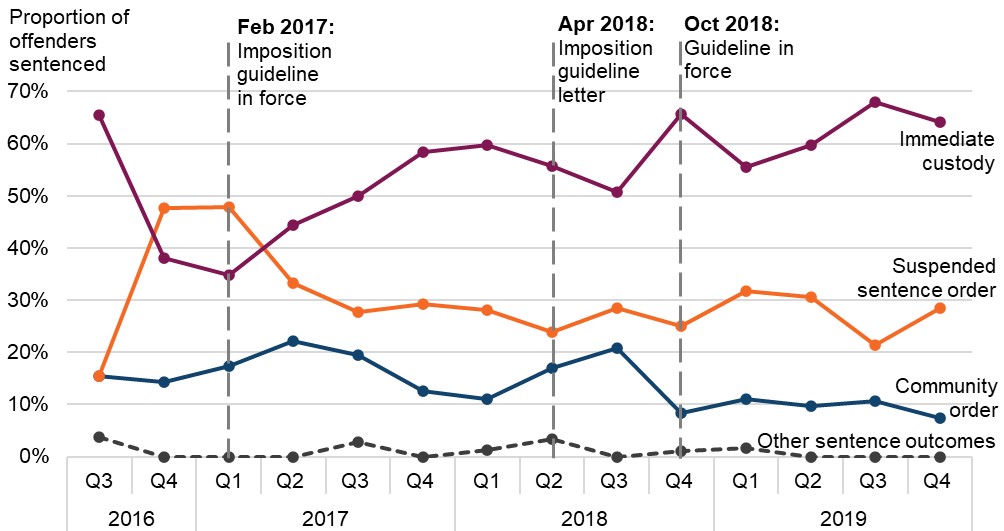
Source: Court Proceedings Database from the Ministry of Justice
Quarter 1 (Q1) covers January to March, Q2 covers April to June, Q3 covers July to September, and Q4 covers October to December. Caution: There are low volumes of offenders sentenced (<30) in Q3 2016, Q4 2016 and Q1 2017 which may contribute to fluctuations in the data across those time periods.
Sentence lengths
Despite the uncertainty regarding the influence of the Controlling or coercive behaviour guideline on sentence outcomes, there does appear to be a clear impact on the average custodial sentence length (ACSL) for this offence (Figure 41). In 2018, there was an increase in ACSL of around 3 months, which continued to increase in 2019 and then stabilised. This fits what might be expected, as 2018 would only include three months of data where cases were sentenced under the Controlling or coercive behaviour guideline, and therefore 2019 would be the first full year of data where all cases were sentenced under this guideline.
The mean ACSL increased from around 16 months in 2017 (before the guideline), to 24 months in 2019 (post guideline), which is an increase of around 8 months. This was not predicted by the resource assessment, which suggested there would be no impacts relating to the guideline.
Figure 41: Average custodial sentence length (ACSL) in months for controlling or coercive behaviour, 2016 to 2022

Source: Court Proceedings Database from the Ministry of Justice
The time series excludes 2015 as no offenders were sentenced for controlling or coercive behaviour in this year.
3.9.4 Transcript analysis
Transcript analysis for controlling or coercive behaviour was undertaken, to review whether there were any implementation issues with the guideline, and the unexpected increase in ACSL.
Transcripts were sampled to be broadly representative of sentencing outcomes and sentence lengths at the Crown Court. As the vast majority of cases are sentenced at the Crown Court (around 90 per cent in recent years) the sample is expected to broadly cover the range of offending for this offence. A total of 34 transcripts from 2020 were examined to identify any emerging issues.
Analysis of ACSLs for this offence showed an increase following the introduction of this guideline, to on average 2 years’ custody post guilty plea. The sentencing table for this offence (Figure 42) indicates that to receive a final sentence of 2 years’ custody or more, offending would most likely be categorised in category ‘A1’ with a starting point of 2 years 6 months’ custody (pre guilty plea). While it is technically possible to receive a custodial sentence of 2 years’ or higher if a case fell into categories ‘B1’ or ‘A2’, this is likely to only be possible where either no, or a low, guilty plea reduction is applied; where plea data is known it indicates that the majority of offenders for this offence do plead guilty.
Figure 42: The sentencing table from the Controlling or coercive behaviour guideline
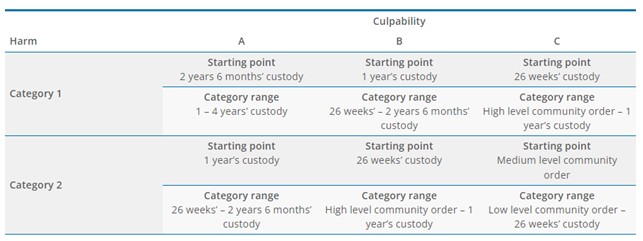
Source: Controlling or coercive behaviour in an intimate or family relationship from the Sentencing Council website
Examination of the 34 transcripts revealed that, where culpability and harm levels had been stated by the sentencer (27 transcripts), nearly two thirds of offenders (59 per cent) were categorised into ‘A1’, and a further 30 per cent fell into ‘A2’. This means, overall, nearly all offenders in this sample, fell into culpability A.
The remaining seven transcripts where culpability and harm had not been stated, were also reviewed. Features of culpability C offending were also not apparent in these transcripts, but the nature of offending suggested they may be more likely to fall into culpability A or B.
Therefore, no transcripts appeared to cover a culpability C case. This may be expected given the starting points for culpability C cases fall within the magistrates’ sentencing powers, and cases seen at the magistrates’ courts are not represented in this sample. However, for ‘C1’ cases, the range does go up to 1 year’s custody which (during the time periods covered by this evaluation) was outside of the magistrates’ sentencing powers.
In addition to examining the distribution of cases across the sentencing table, the frequency with which factors were referenced in assessing culpability and harm was also reviewed. It was possible to undertake this for this offence, due to the higher volume of transcripts within the sample.
For cases which fell into culpability A, where details were provided (20 cases), all of the factors, with the exception of ‘Sophisticated offence’ were referenced. Additionally, it was common for three or four factors to be present for each case, and no individual culpability A factor appeared to be drawing cases into this category.
Figure 43: Culpability A factors from the Controlling or coercive behaviour guideline
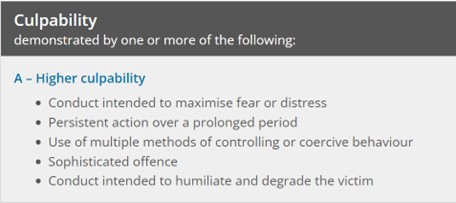
Source: Controlling or coercive behaviour in an intimate or family relationship from the Sentencing Council website
An analysis of culpability B cases was not possible, as there was only one case where details of the culpability had been provided, but in this case the factor was one balancing between culpability A and C, as the guideline specified. No culpability C factors were examined, as no culpability C cases were present in the transcript sample.
The same process was carried out looking at the use of harm factors. There were 13 transcripts which fell into harm 1 and where details of the harm factors were provided. In 12 of the 13 cases, sentencers cited ‘Very serious alarm or distress which has a substantial adverse effect on the victim’. ‘Fear of violence on many occasions’ was explicitly mentioned in nine cases and ‘Significant psychological harm’ was mentioned four times. Furthermore, sentencers often went further to mention use of actual physical violence.
Figure 44: Harm factors from the Controlling or coercive behaviour guideline
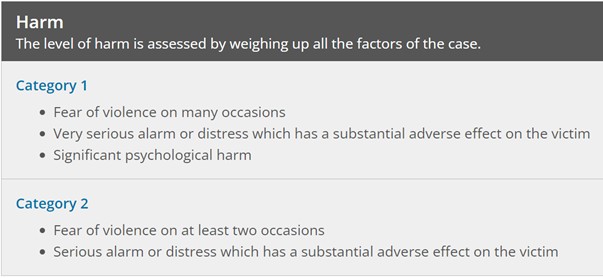
Source: Controlling or coercive behaviour in an intimate or family relationship from the Sentencing Council website
Due to the low number of cases falling into harm 2, there were only 5 cases where detailed information about the harm factors was provided. Sentencers referred to both ‘Fear of violence on at least two occasions’ and the factor of ‘Serious alarm or distress which has a substantial adverse effect on the victim’.
In terms of guideline implementation, no issues were identified from the Crown Court transcripts. Two Court of Appeal transcripts were also examined for the same purpose, but neither transcript indicated any issues.
Overall, transcript analysis suggests that the increase in ACSL may be due to the high proportion of cases potentially falling into culpability A. However, there do not appear to be any singular factors which are drawing cases into culpability A particularly, but instead a combination of several of the factors. There is more of a spread of cases falling into either harm category, so there do not appear to be any issues of note with these categories, and no implementation issues in the Crown Court or small number of Court of Appeal transcripts were identified.
4. Demographic analysis
For each of the offences, CPD data on sex, age and ethnicity of offenders sentenced was analysed to examine whether there were any differences in sentencing outcomes between groups as well as identifying if there were any differences in the impact of the guidelines for offenders of different demographic groups.
Across all offences, the vast majority of offenders were white, and a substantial proportion of offenders also had their ethnicity recorded as ‘Not recorded/not known’. This has meant that across several offences no meaningful analysis can be conducted because the volume of black, Asian, mixed or other ethnicity offenders was so low the comparisons between groups were not robust and/or very limited conclusions could be drawn. This has been noted under each offence section.
Volumes for racially or religiously aggravated stalking and harassment were too low to conduct any demographic analysis and therefore are not discussed below.
4.1 Harassment
Offenders sentenced for harassment are predominantly male (86 per cent in 2022), and 60 per cent of offenders in 2022 were between 30 and 49 years of age. No clear differences in ACSL were found when comparing sex or age groups following the guideline coming into force. Differences in sentence outcomes for male and female offenders were also examined, and it appeared that the introduction of the guideline impacted both male and female offenders similarly (an increase in COs and decrease in SSOs is seen).
There is limited data available on ethnicity; for example in 2022, 20 per cent of offenders had an ‘Not recorded/not known’ ethnicity. Of the offenders where ethnicity was known, 88 per cent were white. Furthermore, due to the very low volumes of black, Asian, mixed or other ethnicity offenders sentenced relative to white offenders, the comparisons of ACSLs and sentence outcomes for each are not robust. However, the limited available data does not indicate any substantial differences in ACSLs or sentence outcomes between these groups following the guideline coming into force.
4.2 Stalking
The profile of offenders sentenced for stalking are similar to harassment; in 2022 around 57 per cent of offenders were between 30 and 49 years of age. Analysis of ACSLs received by different age groups did not indicate any notable differences.
Almost all offenders sentenced for stalking are male (95 per cent in 2022). Comparison of ACSLs between female and male offenders was not possible, as there were not enough female offenders sentenced to immediate custody to allow for a robust comparison. In 2022, around 160 offenders were sentenced to immediate custody, around 150 were male, and fewer than 5 were female. Differences in sentence outcomes between male and female offenders were examined, but again the large difference between offenders sentenced in these groups means analysis is not very robust.
Similar to harassment, there is limited data available on ethnicity; in 2022, 19 per cent of offenders had an ‘Not recorded/not known’ ethnicity. Of the offenders where ethnicity was known, 85 per cent were white. Due to the very low volumes of black, Asian, mixed or other ethnicity offenders sentenced relative to white offenders, the comparisons of ACSLs for each are not robust. Similarly, analysis of sentence outcomes received by different ethnicities of offenders was not possible.
4.3 Harassment (fear of violence) and stalking (fear of violence)
Around 59 per cent of offenders sentenced to harassment (fear of violence) are between 25 to 39 years old, and for stalking (fear of violence) this was 55 per cent in 2022. For these offences analysis indicated no clear differences between age groups.
For both these offences the vast majority of offenders sentenced in 2022 were male (92 per cent for harassment (fear of violence) and 95 per cent for stalking (fear of violence). Comparison of sentence outcomes did not suggest any differences in sentencing for male and female offenders as a result of the introduction of the guideline, although volumes of female offenders were relatively small compared with males, so the comparison may not be robust. As with stalking, no comparison of ACSLs between female and male offenders was possible, due to the volume of female offenders sentenced to immediate custody being too low for a robust comparison.
Over two thirds of offenders were white (68 per cent of offenders sentenced for harassment (fear of violence) and 66 per cent of sentenced for stalking (fear of violence)). Furthermore around 20 per cent of offenders for each offence had a ‘Not recorded/not known’ ethnicity, therefore meaningful analysis comparing ACSLs and sentence outcomes between different ethnicities was not possible.
4.4 Threats to kill
Around 57 per cent of offenders sentenced for threats to kill were aged 30 to 49. For this offence, analysis of the age groups where high enough volumes were available indicated no clear disparities between age groups.
As with the other intimidatory offences, the vast majority of offenders sentenced in 2022 were male (92 per cent). The comparison of ACSLs between female and male offenders suggested that female offenders received lower ACSLs than male offenders from around 2017 onwards. In 2016, both male and female offenders received ACSLs of 17 and 18 months respectively. In 2017, this diverged and female offenders received a much lower ACSL (12 months) compared to male offenders (18 months). From 2019 the increase in ACSL for male offenders broadly stabilised at around 23 to 24 months. Female offenders over this period most frequently received an ACSL of around 15 months. However, the volume of female offenders sentenced each year to immediate custody was low (from around 5 to 20 offenders on any given year), whereas the volume of male offenders fluctuated between 200 to 300 offenders on all but one year (2012), which means comparisons between male and female offenders are not robust.
Analysis comparing sentence outcomes for male and female offenders was not possible. Due to the low volumes of female offenders, there were large fluctuations year-on-year, making it difficult to ascertain any key trends.
Analysis comparing sentence outcomes and ACSLs between ethnic groups was conducted with the exclusion of the other ethnicity grouping where the number of offenders sentenced each year was too low for meaningful comparison. As with other offences, the vast majority of offenders were white, and the next highest volume grouping was ‘Not recorded/not known’, accounting for 20 per cent of offenders in 2022.
The most common sentence outcome for this offence was immediate custody, and analysis showed that post guideline, from 2019 onwards, a higher proportion of black offenders received immediate custody every year other than 2022. As the volumes each year for each ethnicity was low, data for 2019 to 2022 were grouped to identify if these differences remained. The grouped data continued to show that black offenders received the highest proportion of custody at 61 per cent, compared with 52 per cent of white offenders.
The analysis also shows that there does appear to be a slight difference in ACSLs for black offenders, where each year from 2018 to 2022, with the exception of 2020, they received the highest ACSL than any other ethnicity group. As black offenders constituted a small proportion of overall offenders sentenced to immediate custody each year (for example 5 per cent in 2022, which was approximately 10 offenders), data was again grouped to increase volumes. This showed that when grouping 2019 to 2022 data, a period when the guideline was in force, black offenders received the highest ACSL (27 months). This is around 4 months higher than the ACSL white offenders received covering the same period (23 months). It is unclear, however, what would be driving this difference, and whether it is tied to the introduction of the Threats to kill guideline.
4.5 Disclosing private sexual images
Around 59 per cent of offenders sentenced for disclosing private sexual images were between 30 and 49 years old. Differences between the ACSLs received by different age groups was examined, although several age groups were excluded from analysis due to the low volumes sentenced each year, making any comparisons unreliable. However, on the basis of the groups with a high enough volume of offenders for analysis, no clear differences were seen.
As with the other intimidatory offences, the majority of offenders sentenced are male: in 2022 this was 92 per cent. No comparison of ACSLs by sex were possible due to the low volume of female offenders sentenced to immediate custody. Analysis of sentence outcomes were examined from 2016 onwards, and no clear differences as a result of the guideline were found, although again due to the low volume of female offenders sentenced, comparisons between these groups were not robust.
In 2022, the majority of offenders were white (72 per cent), and 21 per cent had an ethnicity ‘Not recorded/not known’. Analysis comparing the ACSLs and sentence outcomes received by different ethnicities was not possible due to the very low volume of black, Asian, mixed and other ethnicity offenders sentenced each year.
4.6 Controlling or coercive behaviour
Similar to the other intimidatory offences, around half (52 per cent) of offenders sentenced to controlling or coercive behaviour were aged between 30 to 49. Overall, analysis comparing ACSLs did not indicate any notable disparities between different ages analysed, although as with other offences the volumes were too low for some of the higher age bands (above 59) to be analysed. Due to the low volumes of black, Asian, mixed and other ethnicity offenders sentenced each year for this offence, comparisons of sentence outcomes by ethnicity were not possible.
Among the intimidatory offences, the offence of controlling or coercive behaviour has the highest proportion of male offenders sentenced in 2022, at around 98 per cent. No comparison of ACSLs or sentence outcomes received by male and female offenders was possible due to very few female offenders being sentenced for this offence since it came into force in 2015.
There is limited data available on ethnicity prior to 2018 as very few offenders were sentenced in 2016, and none in 2015, therefore robust analysis could not be conducted for this period. Additionally, the volume of offenders falling into the other ethnicity category means no analysis can be conducted on this group. From 2018 onwards, there appears to be no consistent differences in ACSLs across the remaining ethnic groups, although the proportion of offenders with a black, Asian or mixed ethnicity in 2022 was very low (a total of 12 per cent), meaning any comparisons between groups are likely not robust. No analysis could be conducted comparing sentence outcomes due to the low volumes of black, Asian, mixed and other ethnicities sentenced for this offence each year.
5. Conclusion
Several of the intimidatory offences guidelines appear to have had unanticipated impacts on the sentence outcomes and in some cases on sentence lengths received by offenders sentenced for these offences. However, there also appears to have been an impact of the Imposition guideline on some of these offences across the time periods being analysed, making it difficult to ascertain the degree to which the changes seen were specifically due to the intimidatory offences guidelines coming into force.
Analysis indicated that while no impact was expected as a result of the Harassment and stalking guideline, it appears to have led to an increase in COs and decrease in SSOs and fines for harassment and may have had an impact on stalking although the data is less clear. For the offences of racially or religiously aggravated harassment/stalking the data did not indicate an impact on sentence outcomes as a result of the guideline, although the resource assessment had indicated a possible increase in sentences for these offences. Additionally, there was no substantial impact on the proportion of immediate custodial outcomes for any of these offences.
The Harassment and stalking (fear of violence) guideline did not appear to have an impact on harassment (fear of violence) sentence outcomes, and the changes seen in the ACSL for this offence were attributed to the change in statutory maximum sentence. Changes were seen in sentence outcomes for stalking (fear of violence), but these may have been related to the introduction of the Imposition guideline due to the timings of when the changes occurred. Sentence lengths increased across the board for stalking (fear of violence) suggesting a combination of the changes to the statutory maximum sentence and the guideline may have played a role in this. Analysis of racially and religiously aggravated harassment or stalking (fear of violence), also covered by this guideline, indicated there were some increases in ACSLs which may be due to the guideline, but low volumes mean it has not been possible to determine this definitively.
The Threats to kill guideline does appear to have increased ACSLs, which was not anticipated by the resource assessment. Analysis of transcripts suggests this may be due to either the starting point for ‘A1’ being higher than offenders were previously receiving for equivalent cases under the MCSG, and/or more cases falling into ‘A1’ than the equivalent MCSG category. Furthermore, demographic analysis suggests that black offenders were more likely to receive a higher ACSL than other ethnicities since 2018 (with the exception of 2020); however it is not clear in what way the guideline may have contributed to this.
Fluctuations in the data for the disclosing private sexual images offence means it has not been possible to determine whether changes in sentence outcomes were due to the Disclosing private sexual images guideline, Imposition guideline or another issue.
Finally, analysis of the Controlling and coercive behaviour guideline has indicated that the guideline may have had an impact on both sentence outcomes (increasing immediate custodial sentences, and decreasing COs), and increasing the sentence lengths issued. Transcript analysis suggests this may be due to the high proportion of offenders falling into the ‘A1’ category.
The Council have discussed the main findings of the evaluation and concluded that no major changes to the guidelines were necessary. However, it has decided to consult on potentially adding wording regarding some observed differences between demographic groups in the Threats to kill guideline.
Acknowledgements
The Sentencing Council would like to thank all the sentencers who completed the data collection forms.
Annex A
Data Sources and Quality
The limitations of the methodology overall, as well as the individual data sources used in this evaluation are discussed in turn below.
General limitations
It has not been possible within the data analysis to control for additional factors e.g. changes in charging decisions for offences, or other guidelines coming into force. As a result, it is not possible to conclude definitively whether the introduction of the guidelines or any other factor caused any changes observed in sentencing outcomes and all findings presented in the report are indicative only. However, where known, factors other than the introduction of the intimidatory offences guidelines which may have impacted sentencing outcomes have been discussed in offence specific sections.
For offences where there are low volumes or smaller sample sizes, there are often larger fluctuations in the data. The findings may therefore not be associated with the introduction of the guidelines but instead be a result of the data being more sensitive to changes. In these cases, one additional record may have a large impact on overall proportions. In bigger samples, each individual record has a relatively lower impact on overall proportions. Low volumes therefore limit the ability to draw conclusions about what changes may or may not be tied to the introduction of the guidelines.
For all offences, the guidelines are intended to promote consistency in sentencing, but this cannot be directly measured using the data available. Guidelines encourage a consistent approach by guiding sentencers through structured, step by step decision making, while still allowing judicial discretion around the final sentence. This allows for a consistent approach to sentencing, but some variation in outcomes for offences that on the face of it appear to be very similar. It is not possible to control for the large number of complex factors which are considered when deciding a sentence, and the Council’s research into consistency has shown that this is a challenging area to measure. Therefore, this report will not cover whether consistency in sentencing has been impacted by the introduction of the guidelines. However, the Council is continuing to explore options for measuring consistency as part of its wider work.
Court Proceedings Database
The Court Proceedings Database (CPD) is maintained by the Ministry of Justice (MoJ). Every effort is made by MoJ and the Sentencing Council to ensure that the figures presented in this publication are accurate and complete. However, it is important to note that these data have been extracted from large administrative data systems generated by the courts and police forces. As a consequence, care should be taken to ensure data collection processes and their inevitable limitations are taken into account when those data are used. Further details of the processes by which MoJ validate the records in the CPD can be found inside the ‘Technical Guide to Criminal Justice Statistics’ within the Criminal Justice System Statistics Quarterly (CJSQ) publication.
The data presented in this evaluation from the CPD only include cases where the specified offence was the principal offence committed. When an offender has been found guilty of two or more offences, the principal offence is the offence for which the heaviest penalty is imposed. Where the same disposal is imposed for two or more offences, the offence selected is the offence for which the statutory maximum penalty is the most severe. Although the offender will receive a sentence for each of the offences that they are convicted of, it is only the sentence for the principal offence that is presented here.
The average custodial sentence lengths provided are mean and median average custodial sentence length values for offenders sentenced to determinate custodial sentences, after any reduction for guilty plea. This calculation therefore excludes indeterminate sentences (life sentences or Imprisonment for Public Protection, IPPs). This approach for calculating an ACSL is consistent with that used for sentencing statistics produced by the Ministry of Justice. Figures in this report demonstrating changes in ACSL over time only include data where more than five offenders have been sentenced to immediate custodial sentences.
Figures may differ from those published by the MoJ, as we have excluded 42 harassment cases, six harassment (fear of violence) cases, one stalking (fear of violence) case, three threats to kill cases and one disclosing private sexual images case in the CPD between 2012 to 2016 which were not sentenced.
Some figures presented include the time period from March 2020 in which restrictions were initially placed on the criminal justice system due to the coronavirus (COVID-19) pandemic, and the courts’ recovery since. It is therefore possible that these figures may reflect the impact of the pandemic on court processes and prioritisation and the subsequent recovery, rather than a continuation of the longer-term series, so care should be taken when interpreting these figures.
The result category ‘Other/unknown’ includes cases where the outcome categorised in the CPD was ‘Otherwise dealt with’, which covers multiple miscellaneous disposals, and those cases where the disposal was not known.
Ethnicity data presented in this report is the self-identified ethnicity as defined by the individual. For more information on how this data is collected can be found within the ‘Technical Guide to Criminal Justice Statistics’ within the Criminal Justice System Statistics Quarterly (CJSQ) publication.
Magistrates’ court data collection
A detailed examination of the quality of the data collection data can be found in the Background Quality Report, however a few key limitations are set out below.
The magistrates’ court data collection returned low response rates, meaning there is a risk the data is not representative of all harassment or stalking offending. The low response rate also meant it was not possible to conduct significance testing as the volumes of specific factors were not high enough to conduct robust analysis.
Differences in the pre and post guideline data collection instrument and therefore the resulting datasets made it difficult to create a direct comparison across many key factors (e.g. the seriousness and culpability and harm assessments are measured differently in each as a result of the differences between the guidelines used in the pre and post time periods). This again, inhibited the ability to conduct significance testing.
In addition, the forms for the collections were filled in by sentencers in an operational setting. The quality of the data returned therefore depends on sentencers having had the time to record the details of the case accurately and having interpreted the form correctly and completely.
Transcripts
The sample of sentencing transcripts from the Crown Court can only provide indicative evidence due to the small number reviewed and variations in the level of detail across transcripts. Additionally, as sentencing transcripts are only available for the Crown Court, data is not available from this source on offending seen at the magistrates’ courts. This means the Crown Court transcript sample may provide an incomplete picture of offending for either-way offences.
Court of Appeal transcripts were also requested for successful appeals from 2022 across the intimidatory offences. These were included as they may be able to help identify specific issues with the guideline where cases were successfully appealed because of issues in application of the guideline.
However, the volume of successful appeals for these offences was very low – in some cases only one or two for a given offence, and in some cases none were available. A lack of successful appeals does not necessarily indicate that there are no issues with the guideline. Firstly, there may be cases where issues arise due to the guideline, but appeals are not made. Additionally, appeals which are made, may end up being dismissed or withdrawn before a decision is made e.g. if deadlines were missed, or the applicant withdrew their application. Therefore, findings from the Court of Appeal transcripts are also only indicative.
Annex B
Changes since the introduction of the intimidatory offences guidelines
There have been some small changes to the intimidatory offences guidelines since they came into force on 1 October 2018. The original versions of the guidelines (now archived) reflect the guidelines as they were published on October 2018 and are the version on which this evaluation is based The versions of the guidelines on the Sentencing Council website, which are currently in use, include any changes made since the guideline came into force.
Any changes which were relevant to the interpretation of the sentencing data have been discussed within the main report. Changes referred to here are not expected to have had any or a substantial impact on sentencing outcomes.
New step for racial and religious aggravation
A change was made to create a separate step for the uplift for two intimidatory offences guidelines: the Harassment and stalking guideline, and the Harassment and stalking (fear of violence) guideline. The aim of this was to bring these guidelines into line with the format used in assault guidelines, to give the uplift process prominence, and to make it easier to signpost the step.
Additionally, new wording was added at step 1 ‘For racially or religiously aggravated offences the category of the offence should be identified with reference to the factors below, and the sentence increased in accordance with the guidance at Step 3’. The miscellaneous amendments consultation response document indicated this would not make a substantive change to the guideline, but instead was to improve clarity and transparency. The racially and religiously aggravated information in the guideline itself did not change (it was previously included under step 2), but has just been separated out under a new heading of step 3. This change came into force on 1 April 2022.
As the transcripts analysed in this report cover the time period before these changes were made, any impacts on interpretation of findings will be referenced in the relevant transcript analysis sections (3.5.4 and 3.6.4).
Compensation
Changes were made across all relevant guidelines (including all intimidatory offences guidelines) to the wording on compensation. This change came into force on 1 April 2022. This report does not examine any impacts relating to compensation, and so this will not impact interpretation of any findings. Details of this change and expected impacts can be found in the miscellaneous amendments consultation response document.
Expanded explanations and mitigating factors
On 1 April 2024 several changes were made to mitigating factors and/or their expanded explanations relating to: remorse, positive character, age/lack of maturity, sole or primary carer and determination to change offending behaviour.
Additionally, three new mitigating factors were added: ‘Difficult/deprived background or personal circumstances’, ‘Prospects of or in work, training or education’ and ‘Pregnancy, childbirth and post-natal care’.
These changes were made across all relevant guidelines including intimidatory guidelines, and more detail can be found in the miscellaneous amendments consultation response document.
The miscellaneous amendments consultation document outlines some potential impacts of these changes. However, analysis in this report covers up to the year 2022, before these changes came into effect. Additionally, as these changes do not relate specifically to the intimidatory offences guidelines (they have been applied to all relevant guidelines), and do not amend any specific parts of the intimidatory offences guidelines under review, these will not be discussed further within this evaluation.